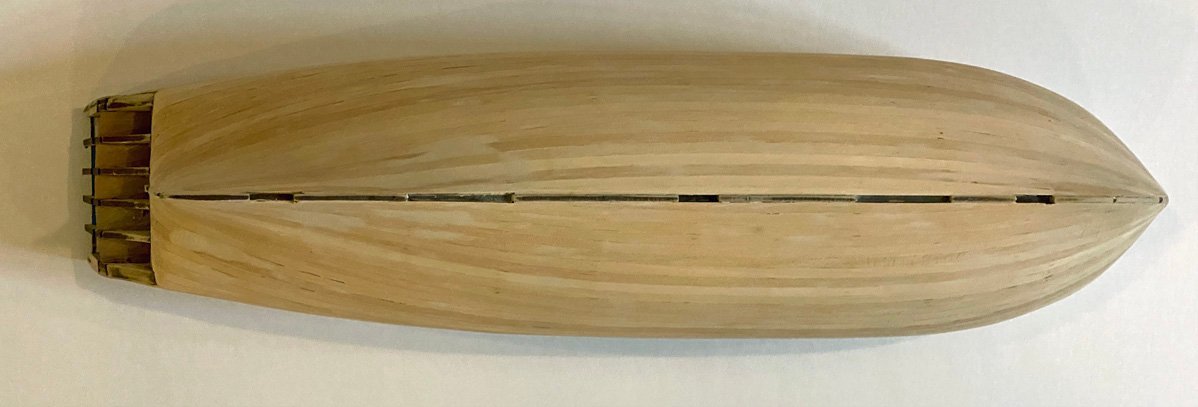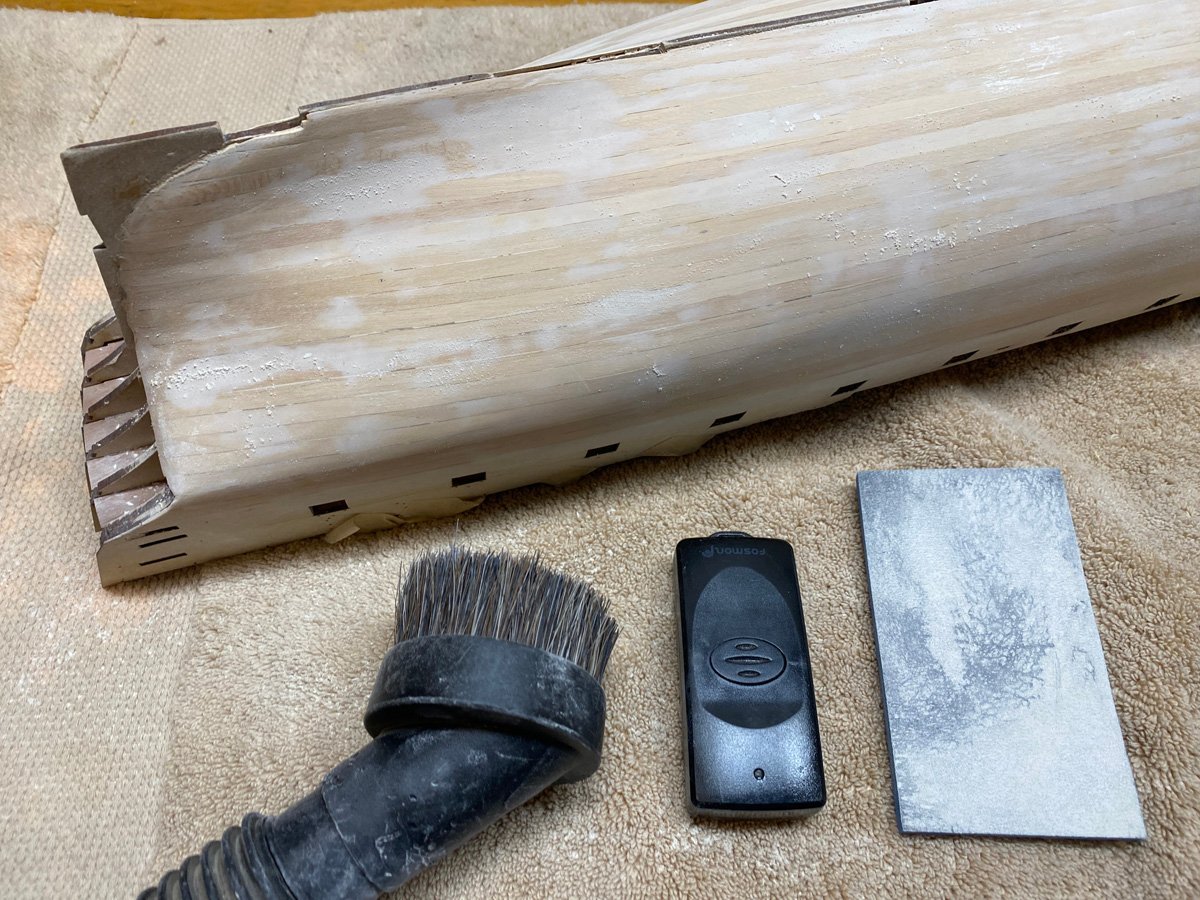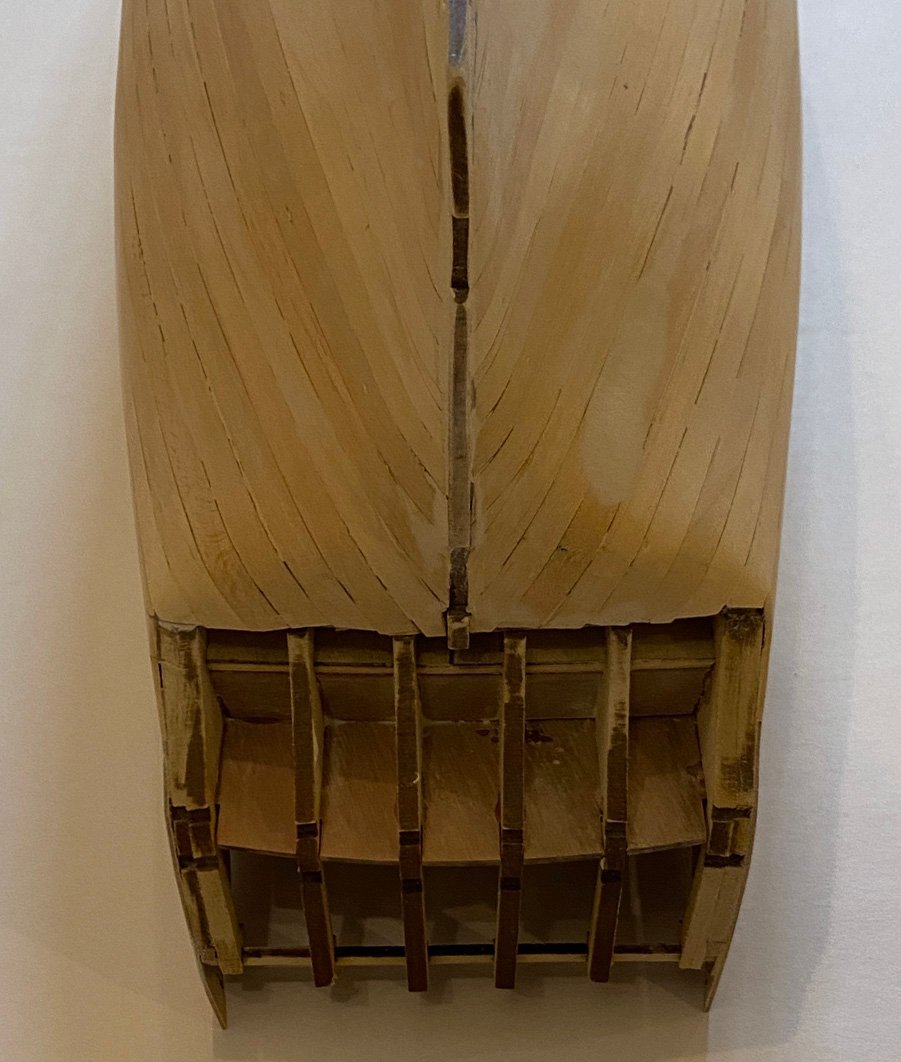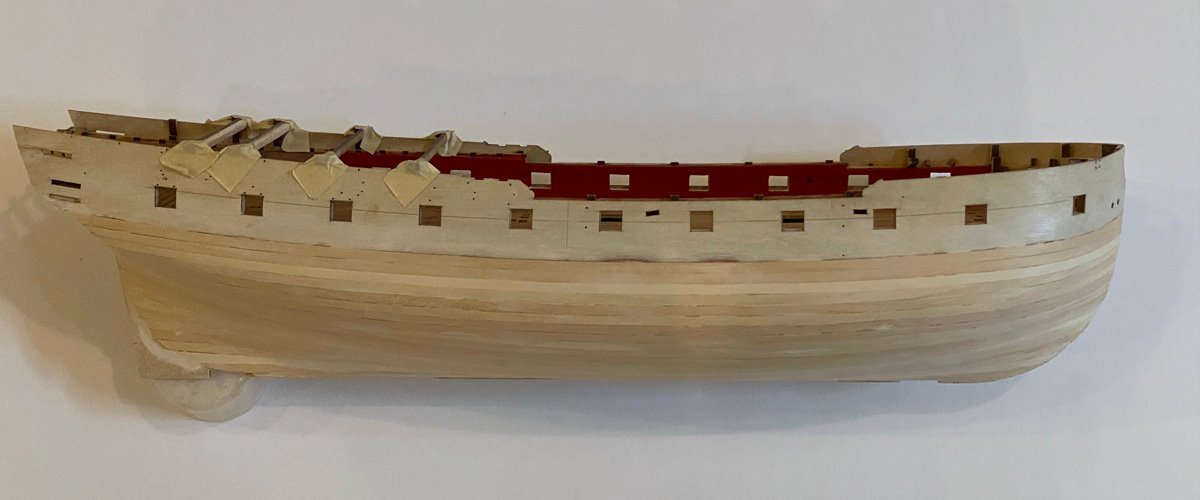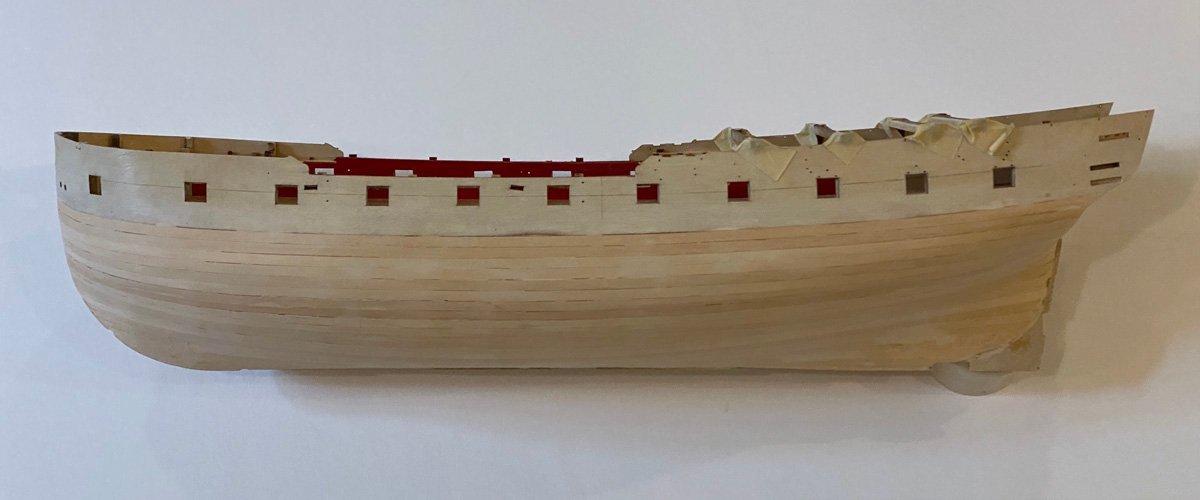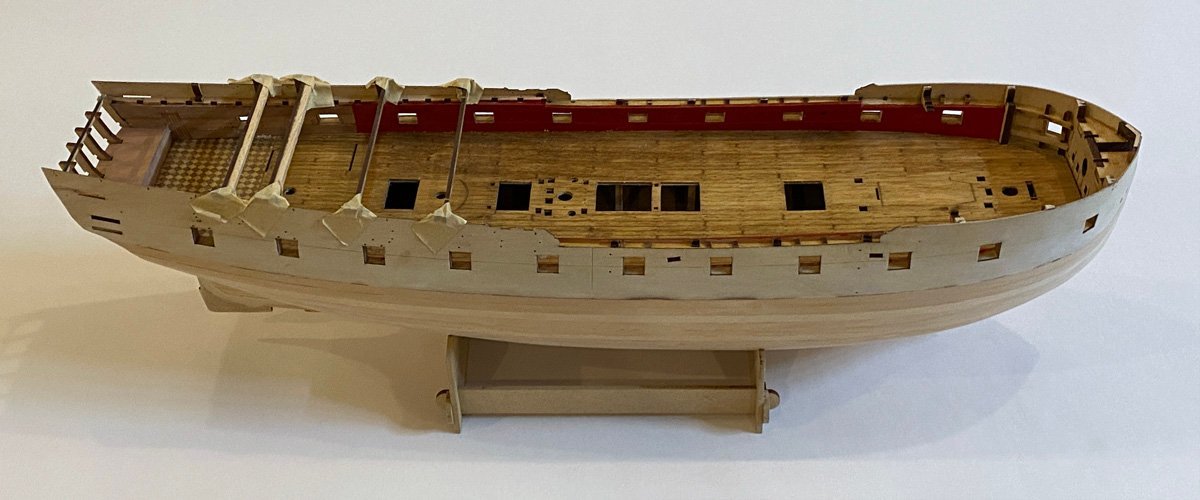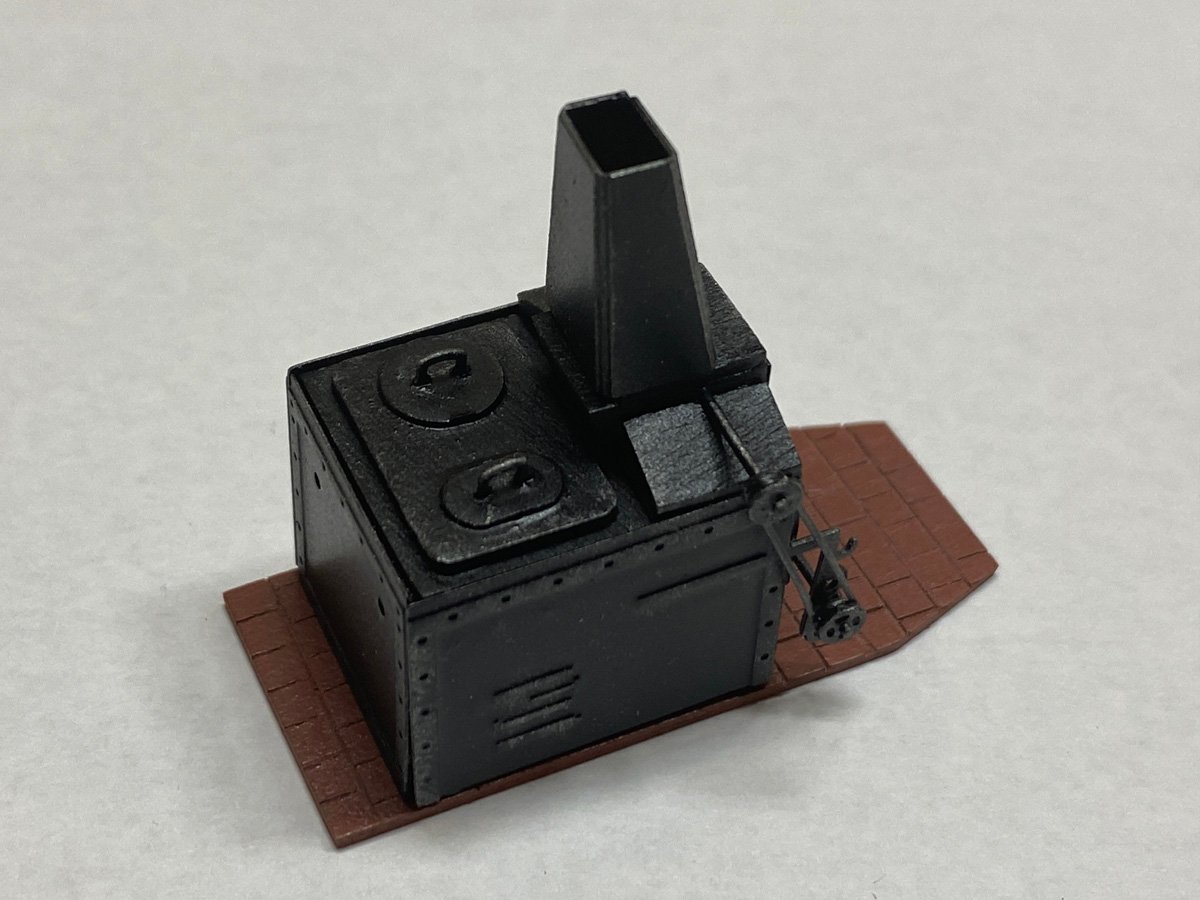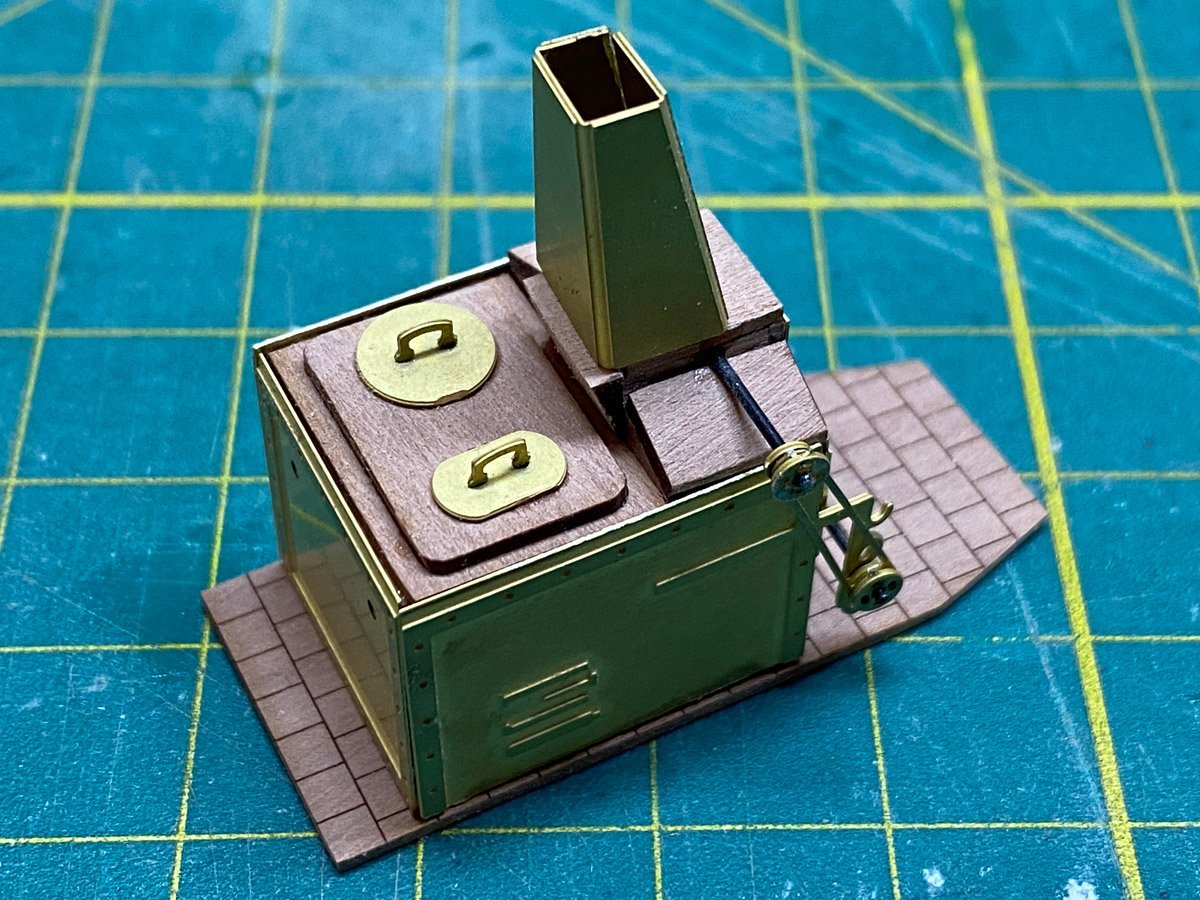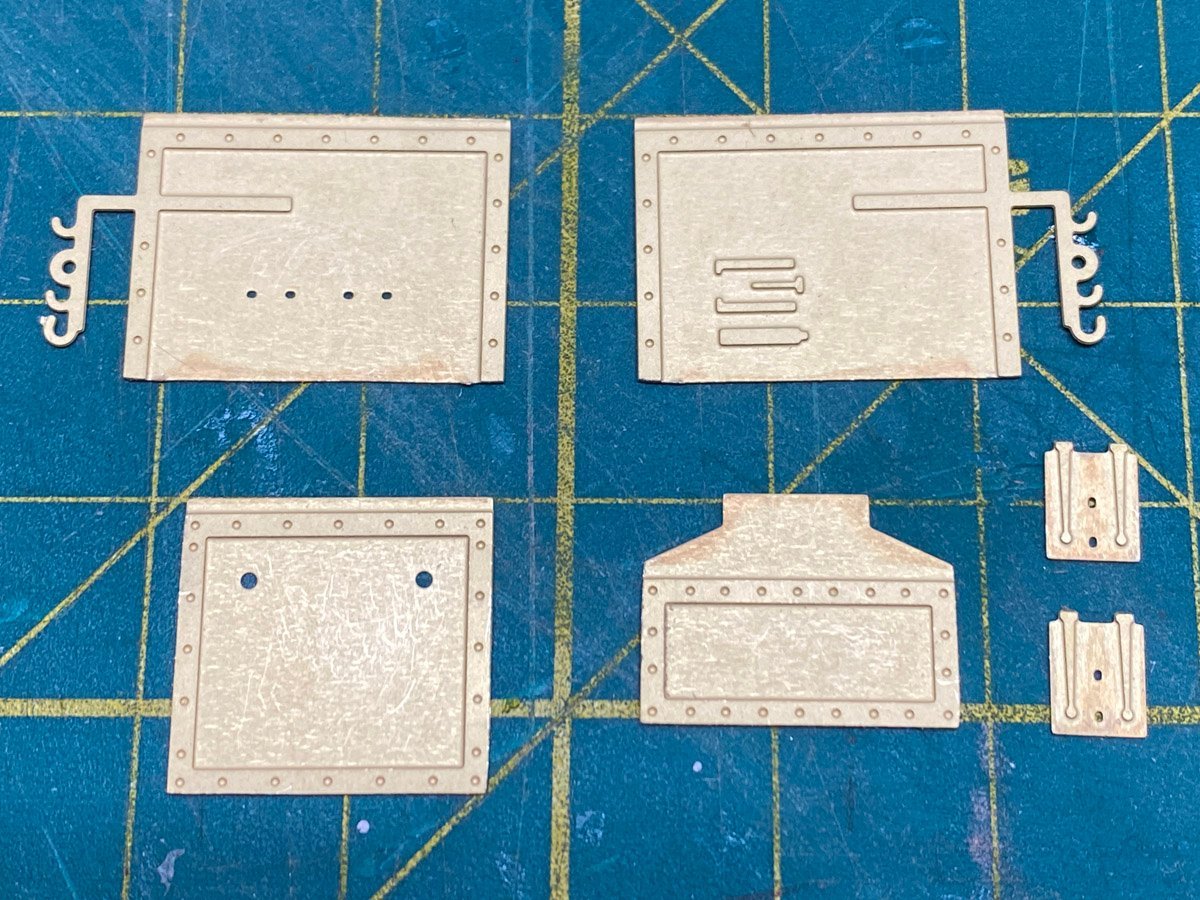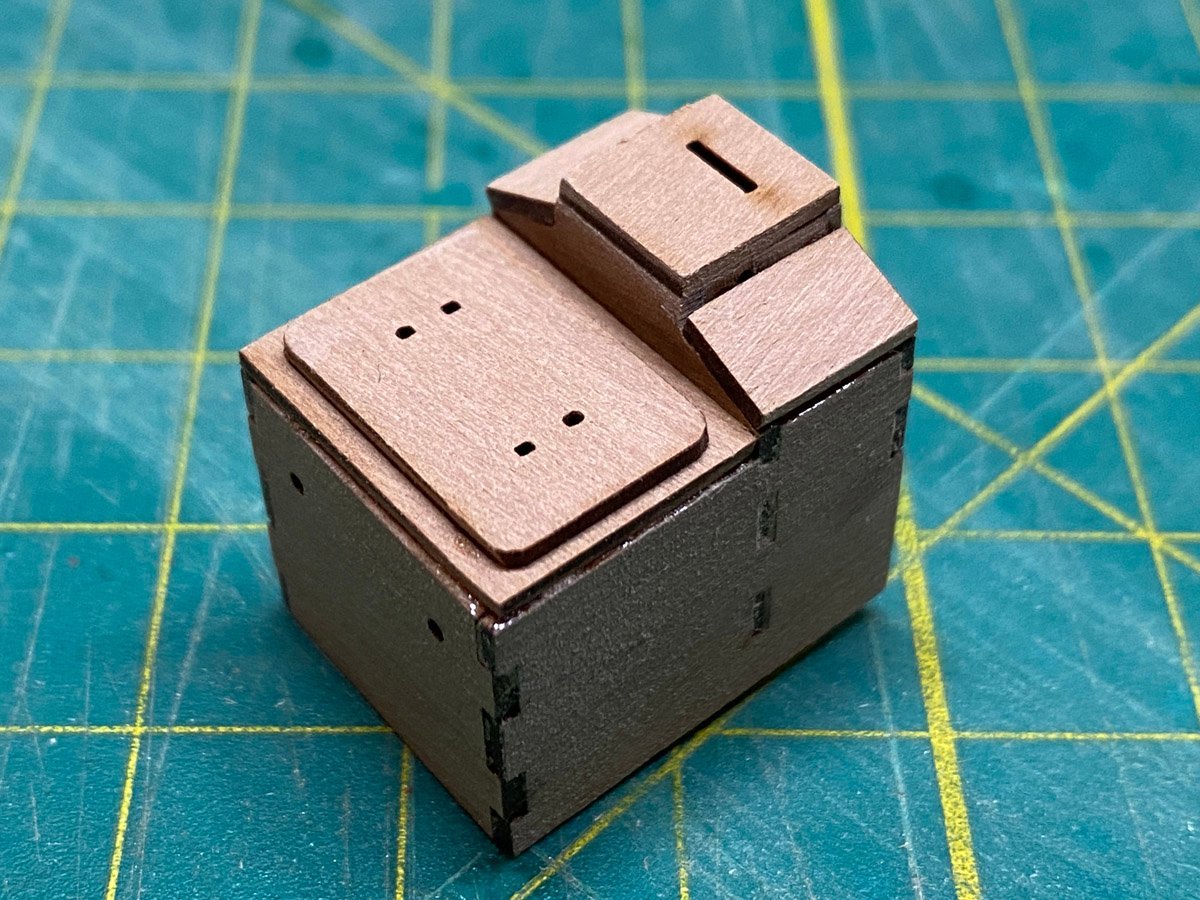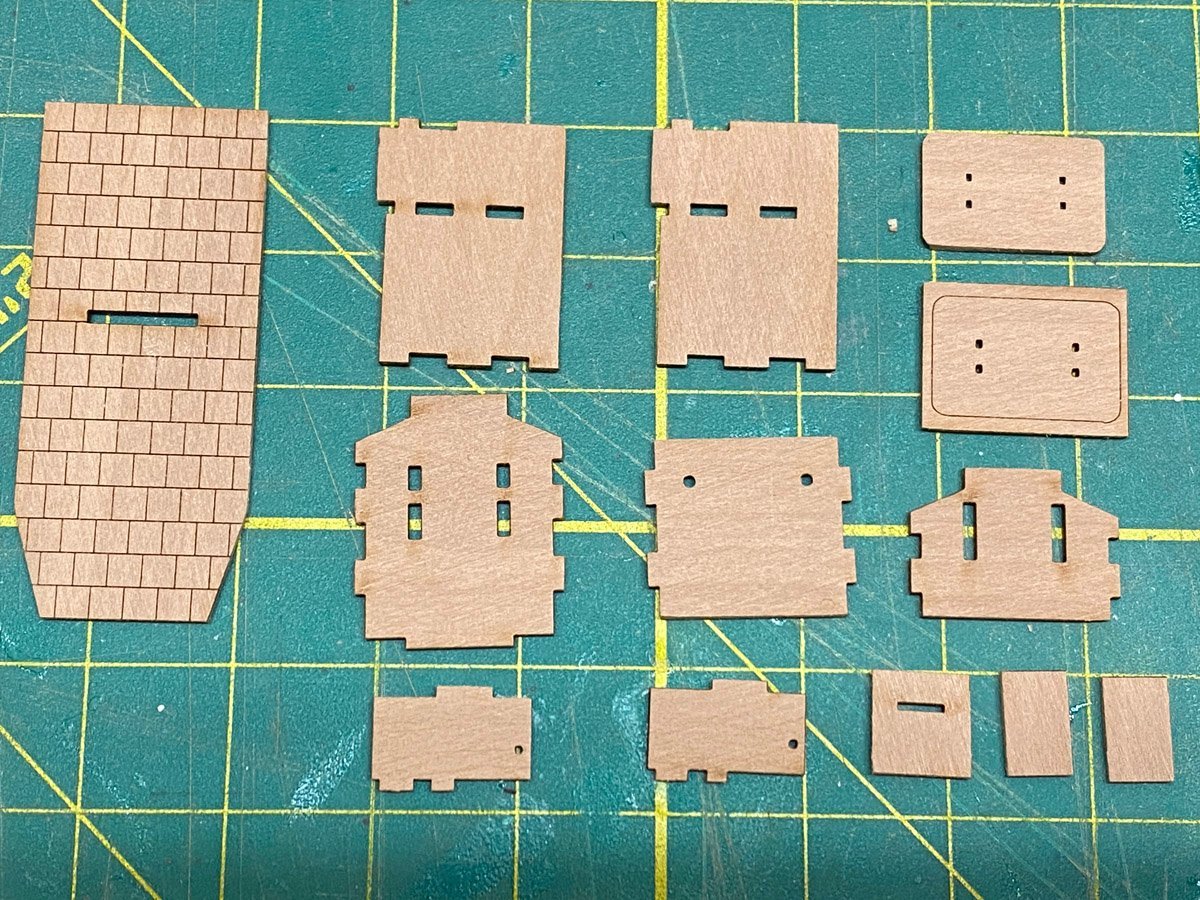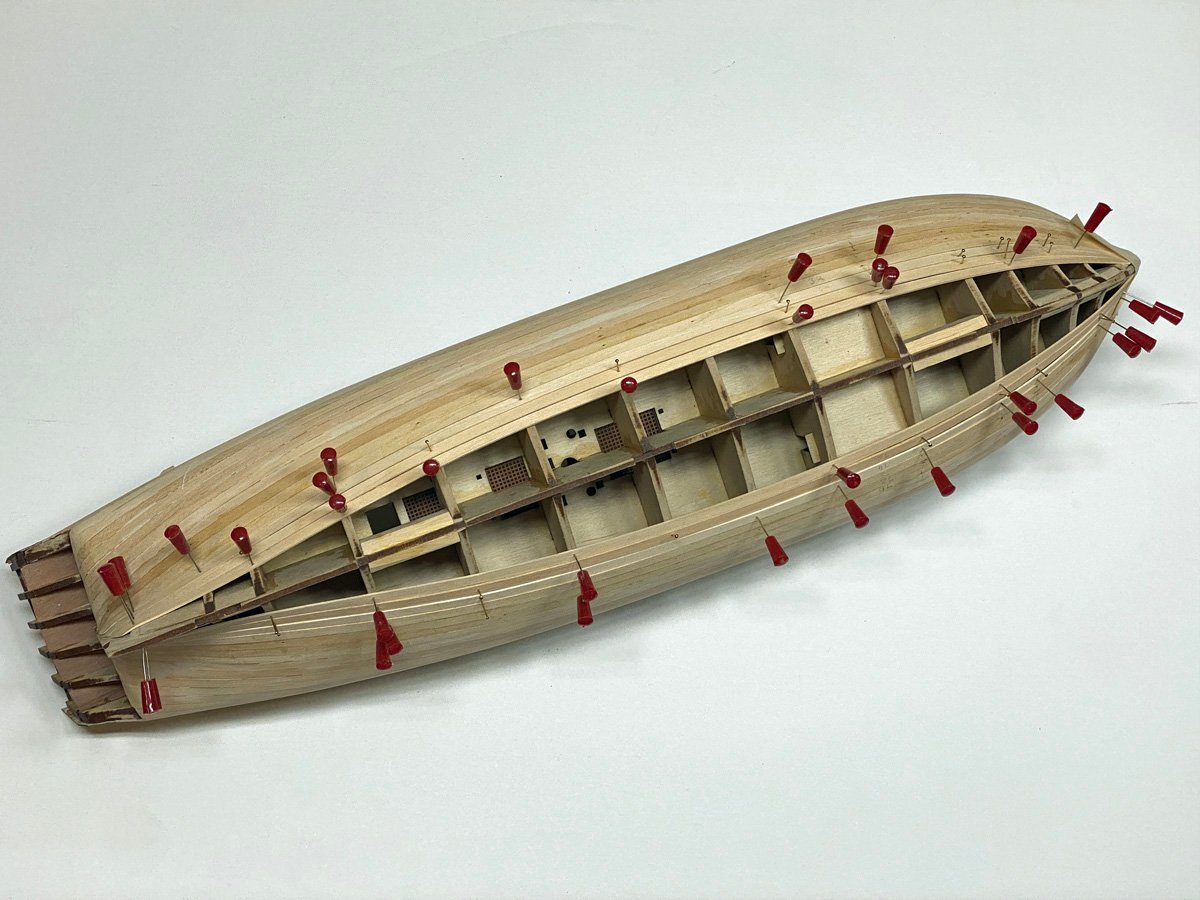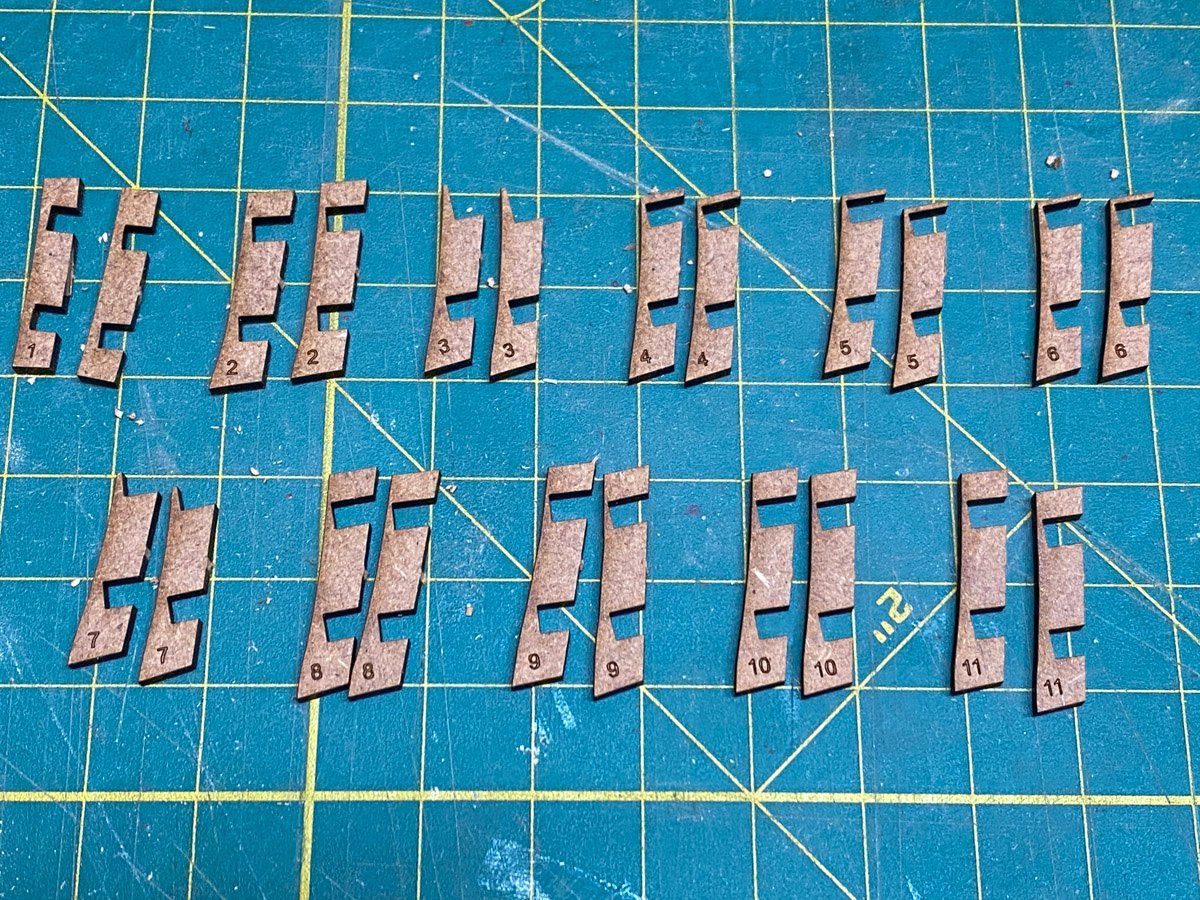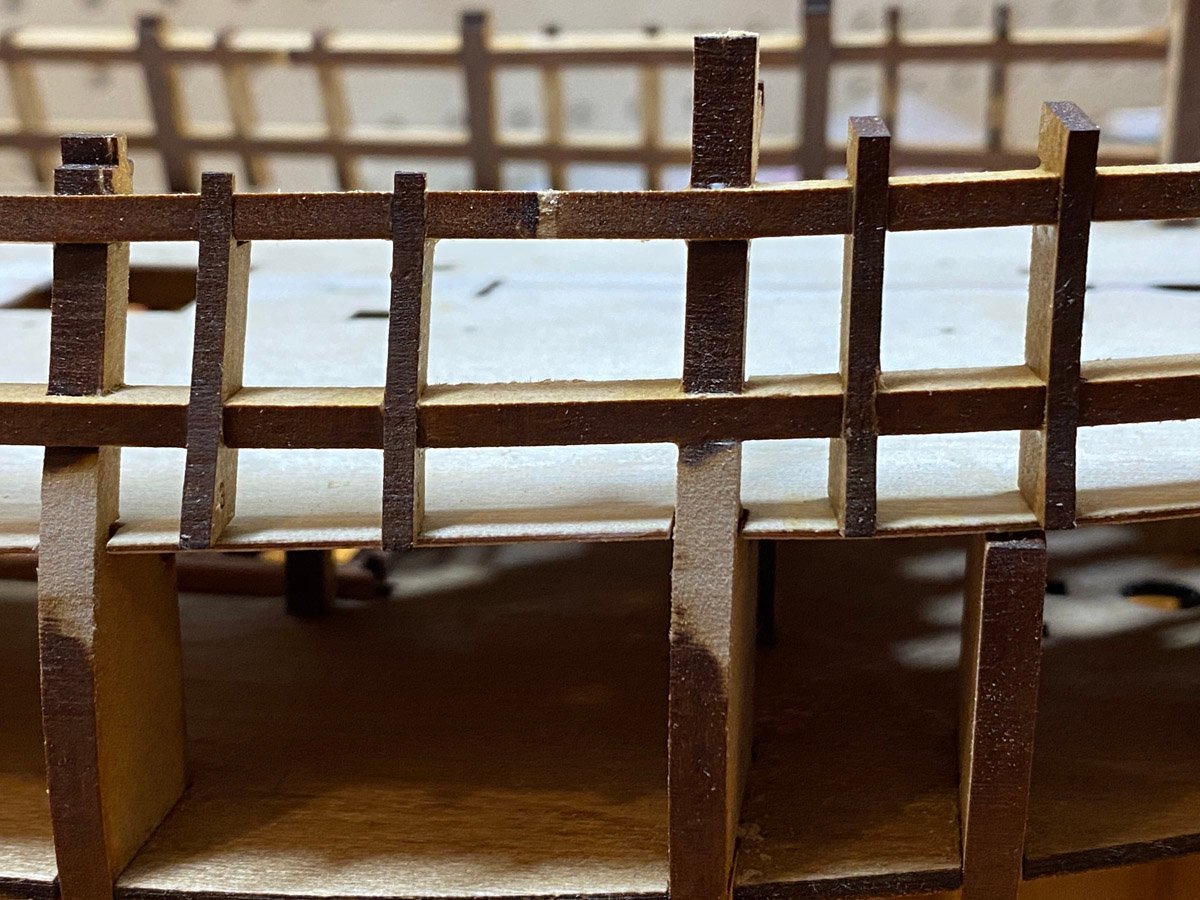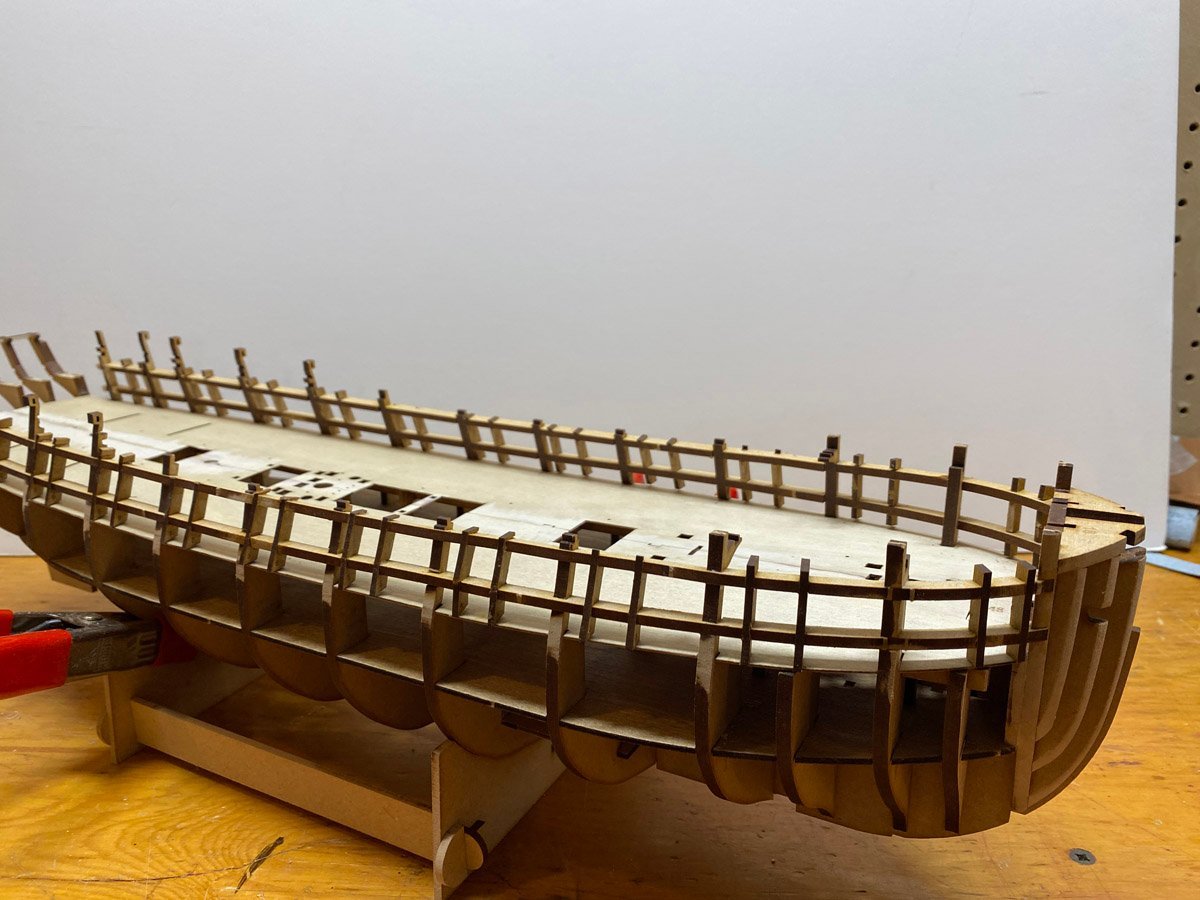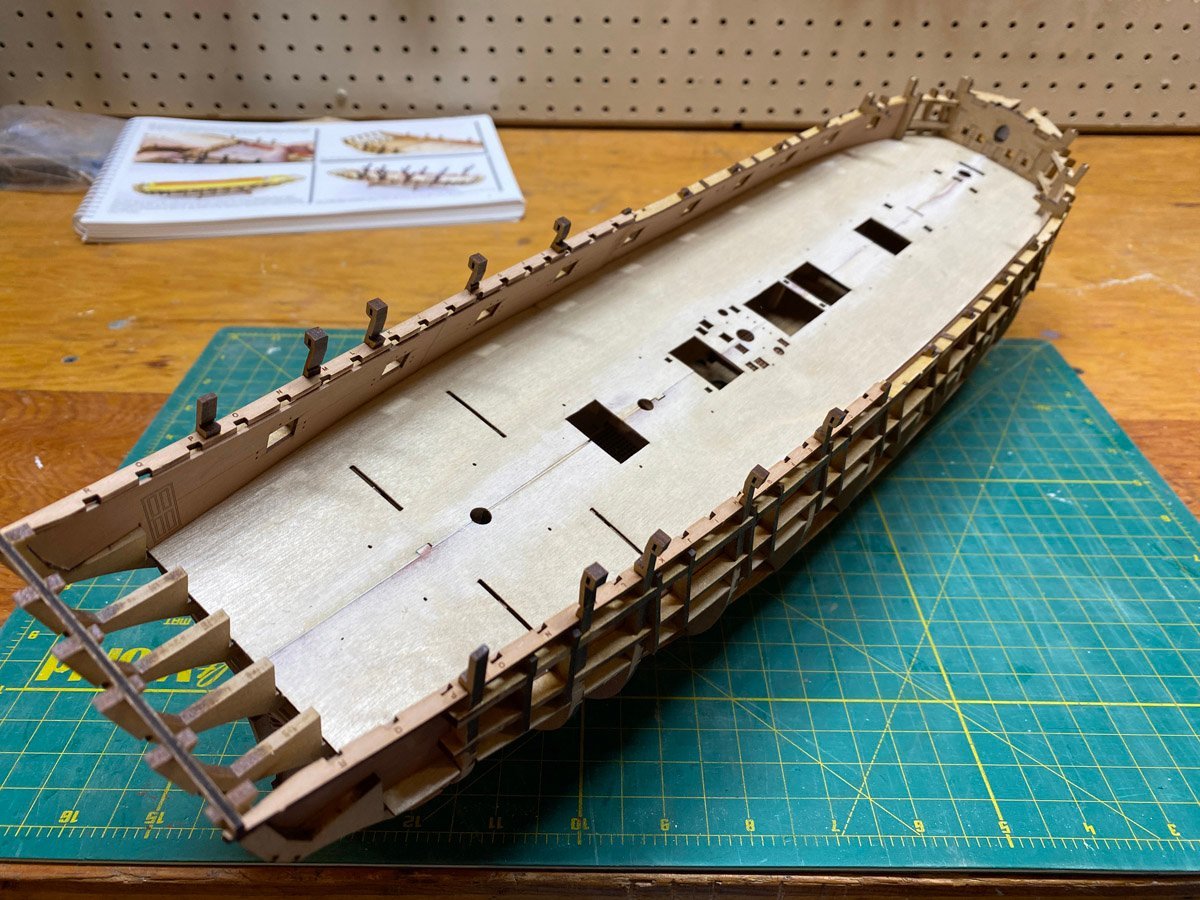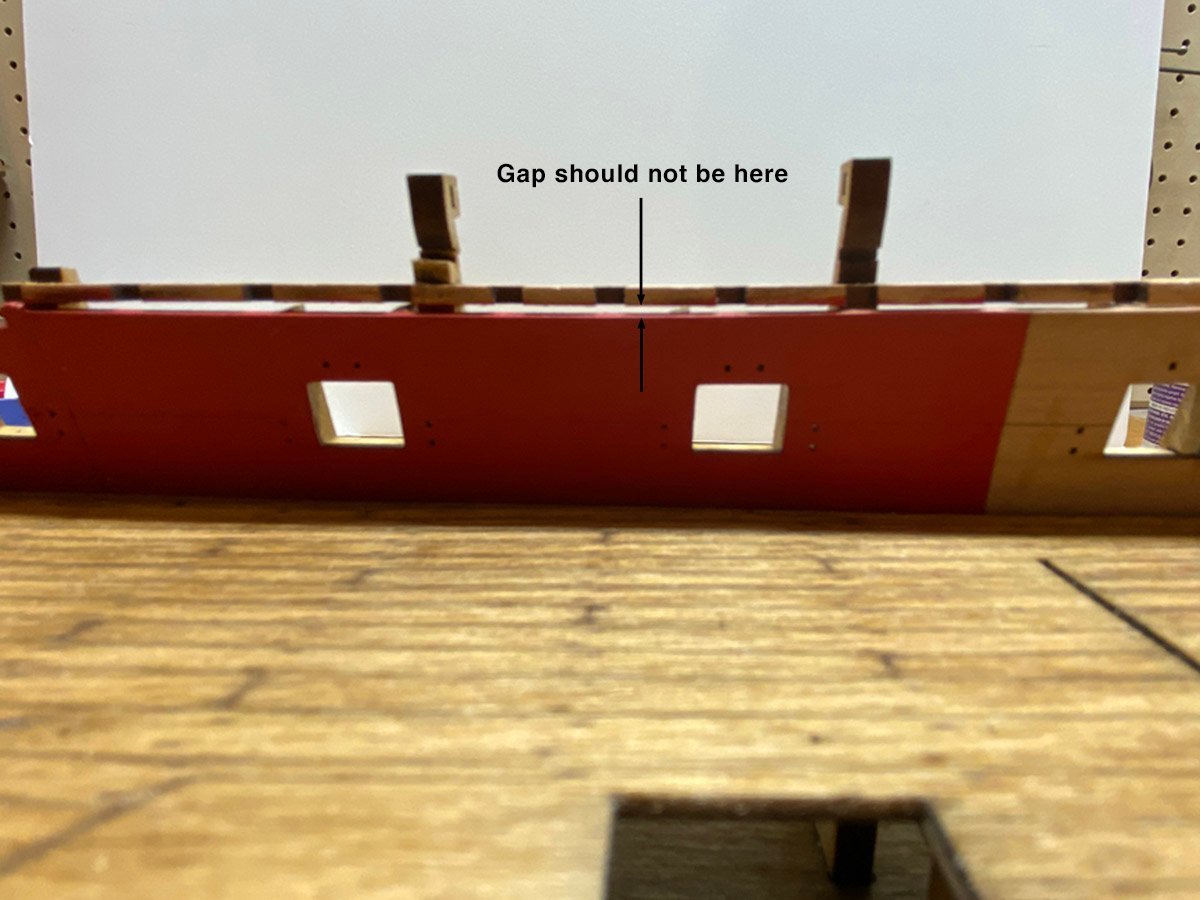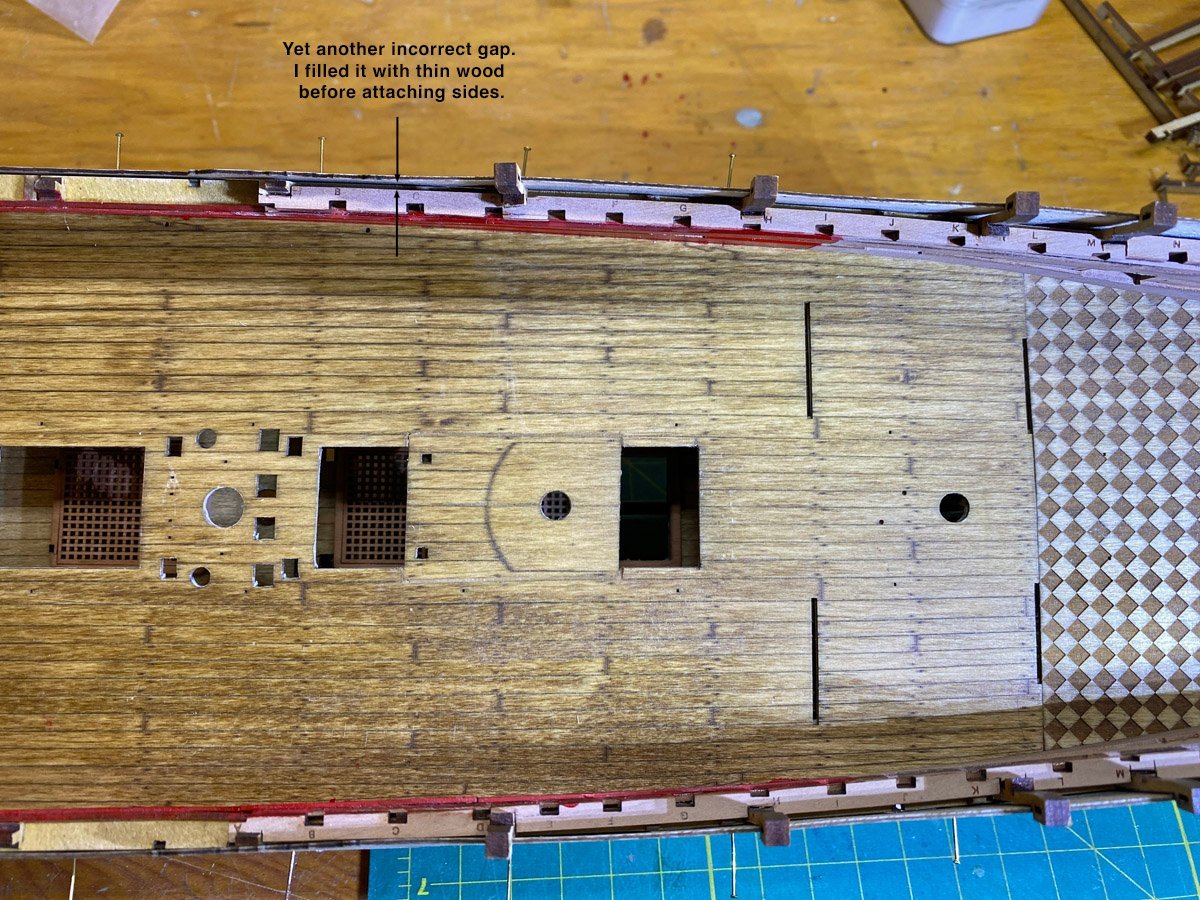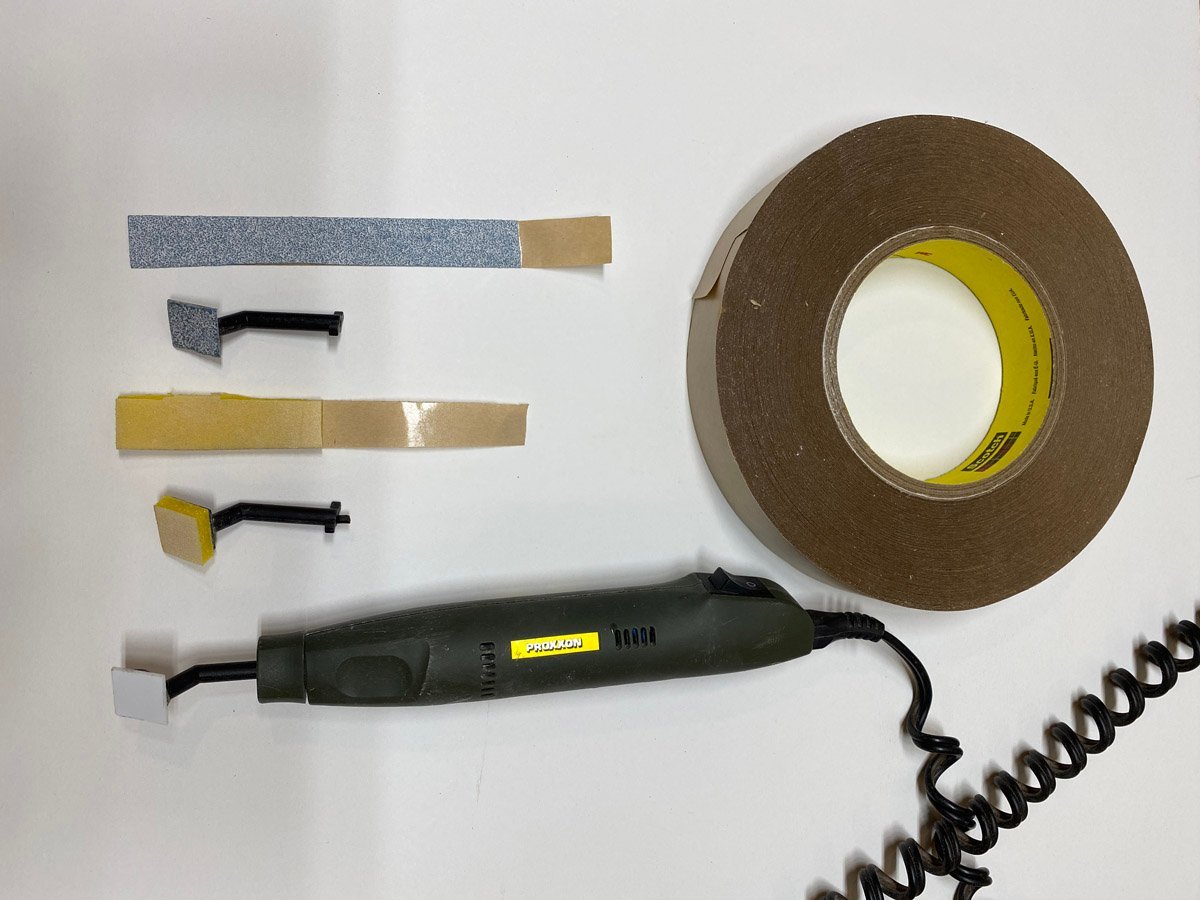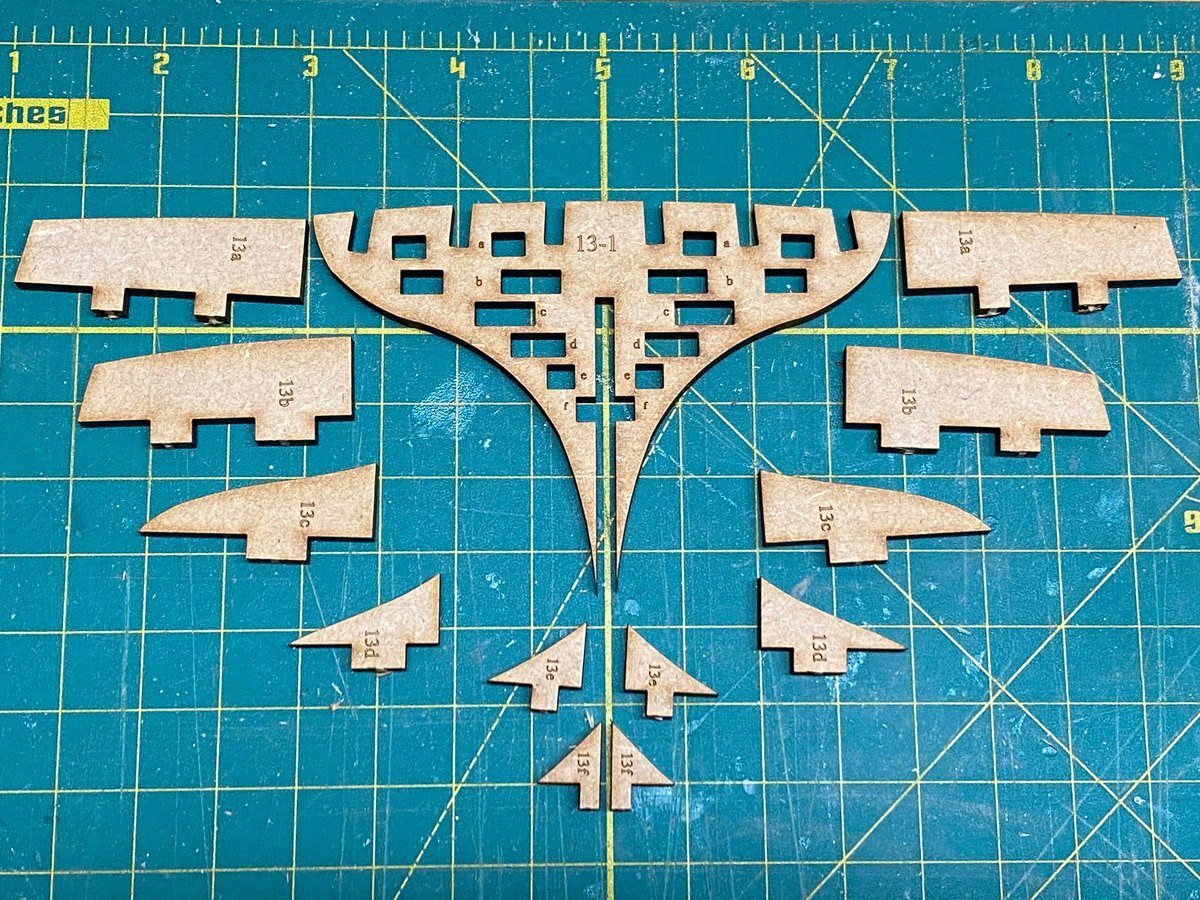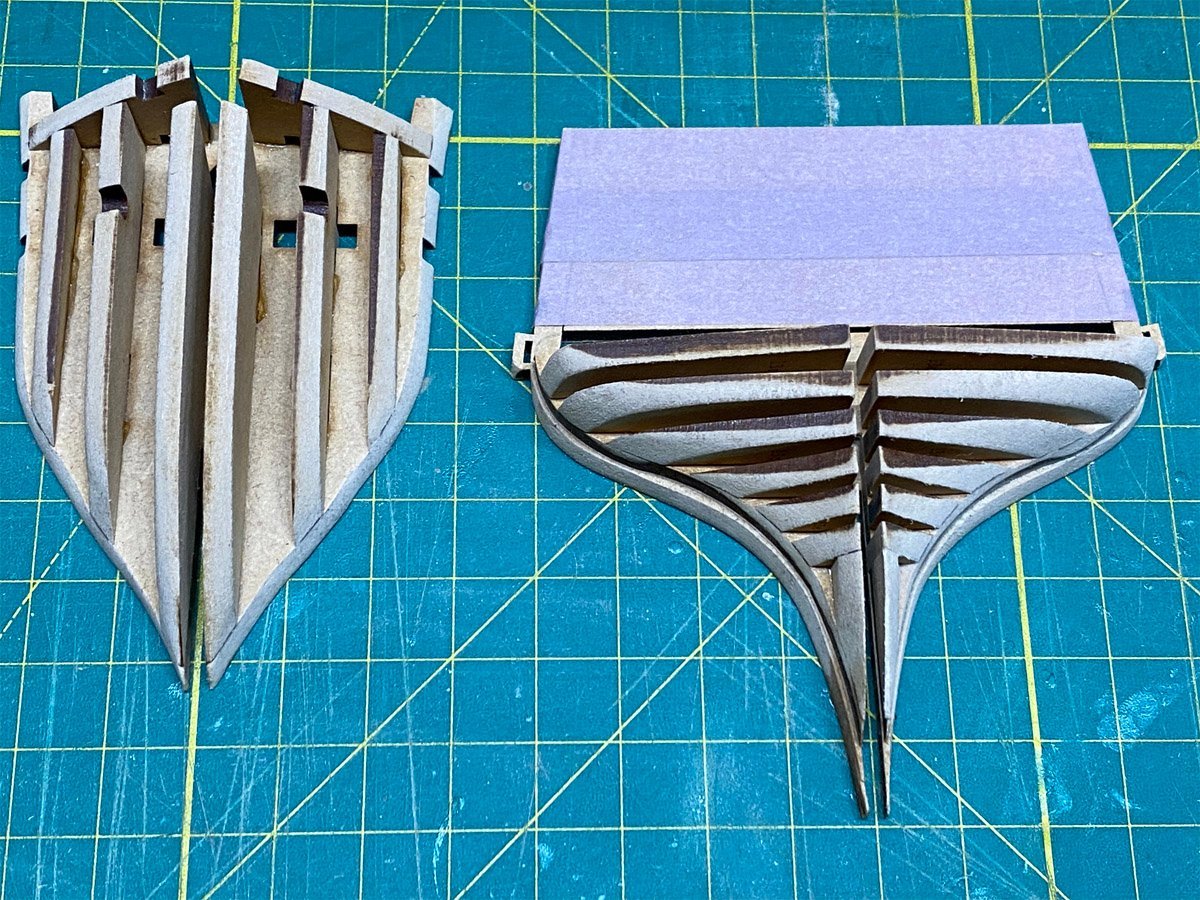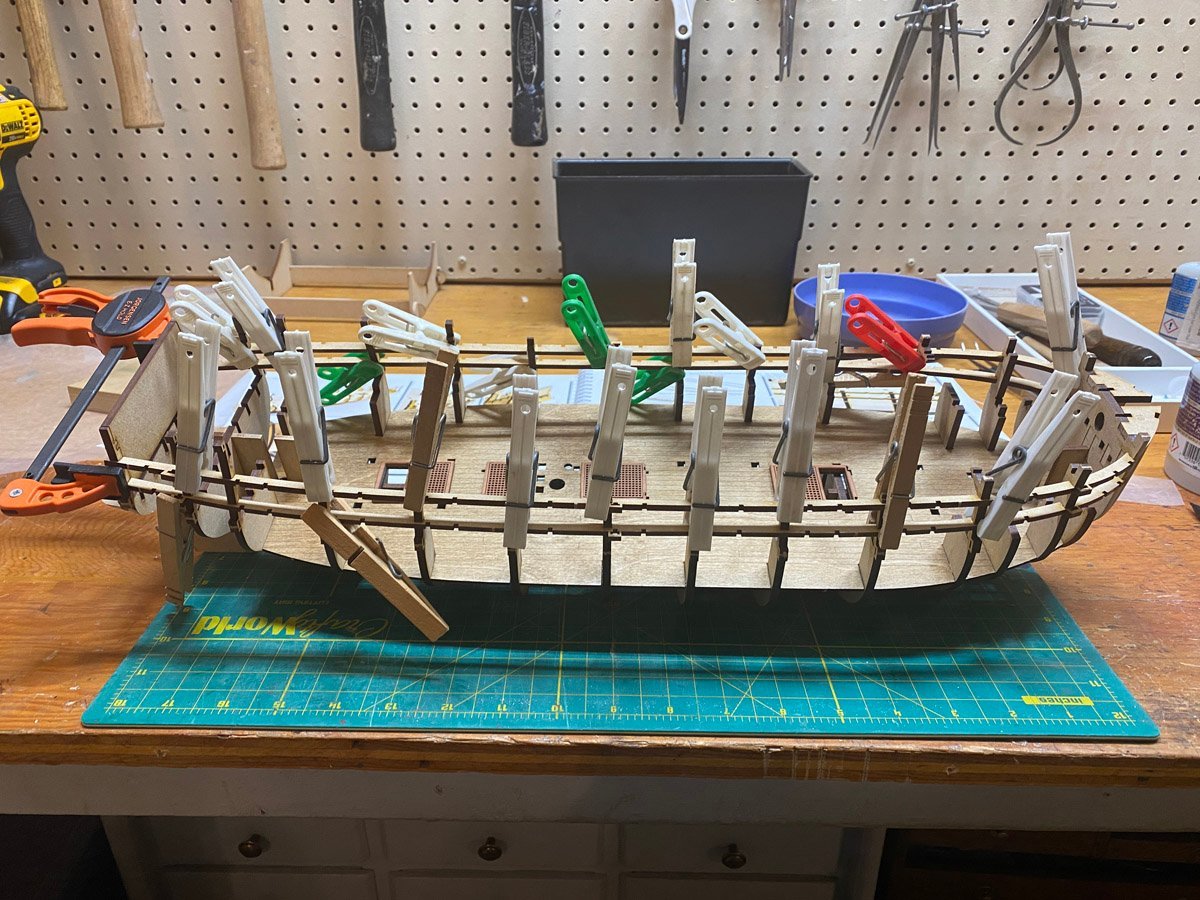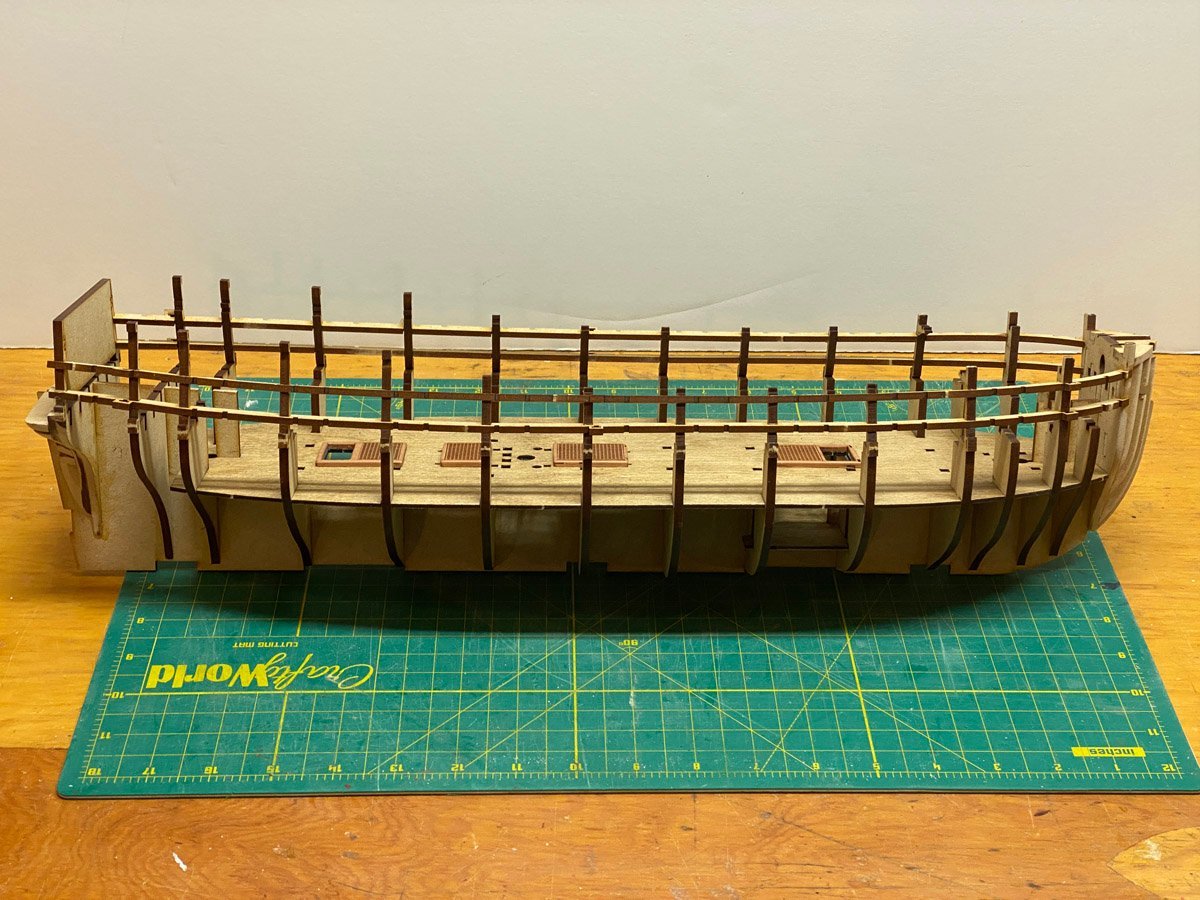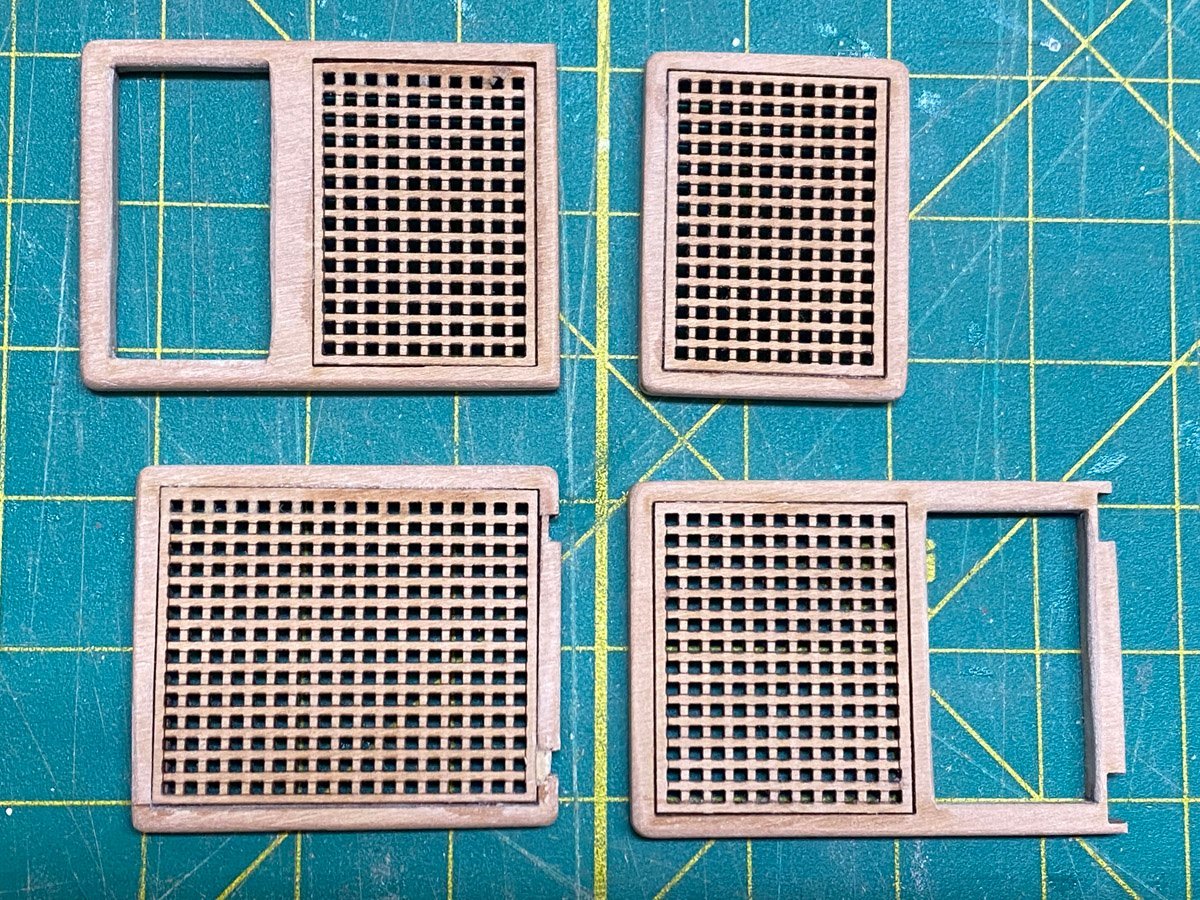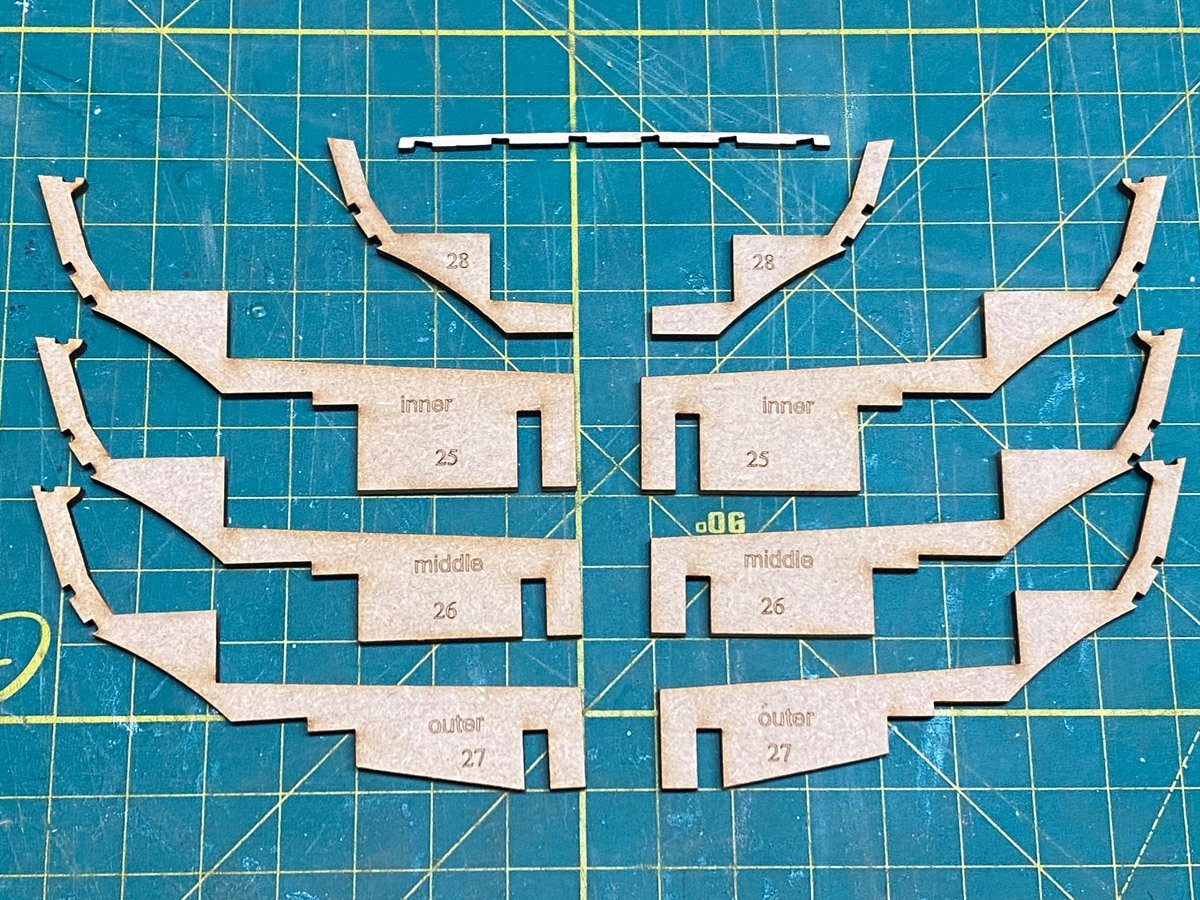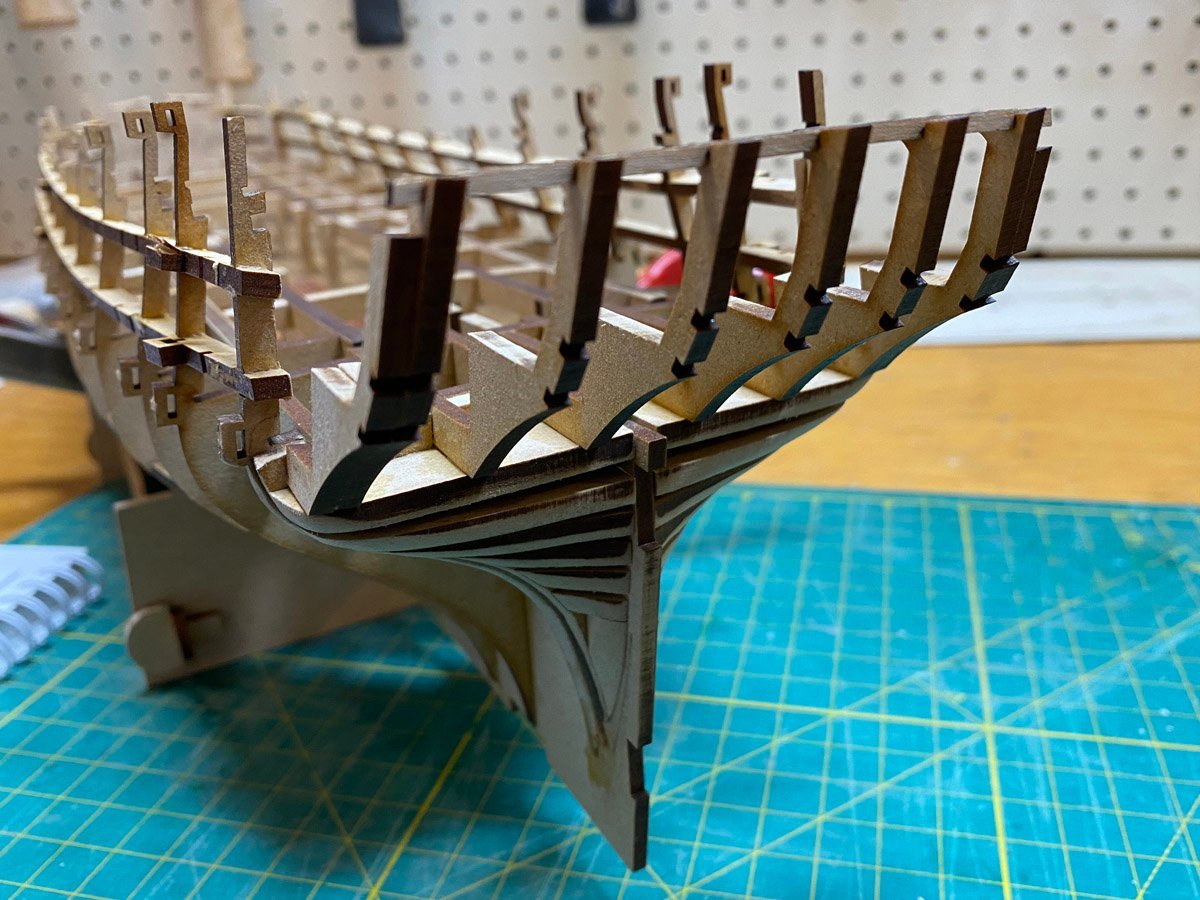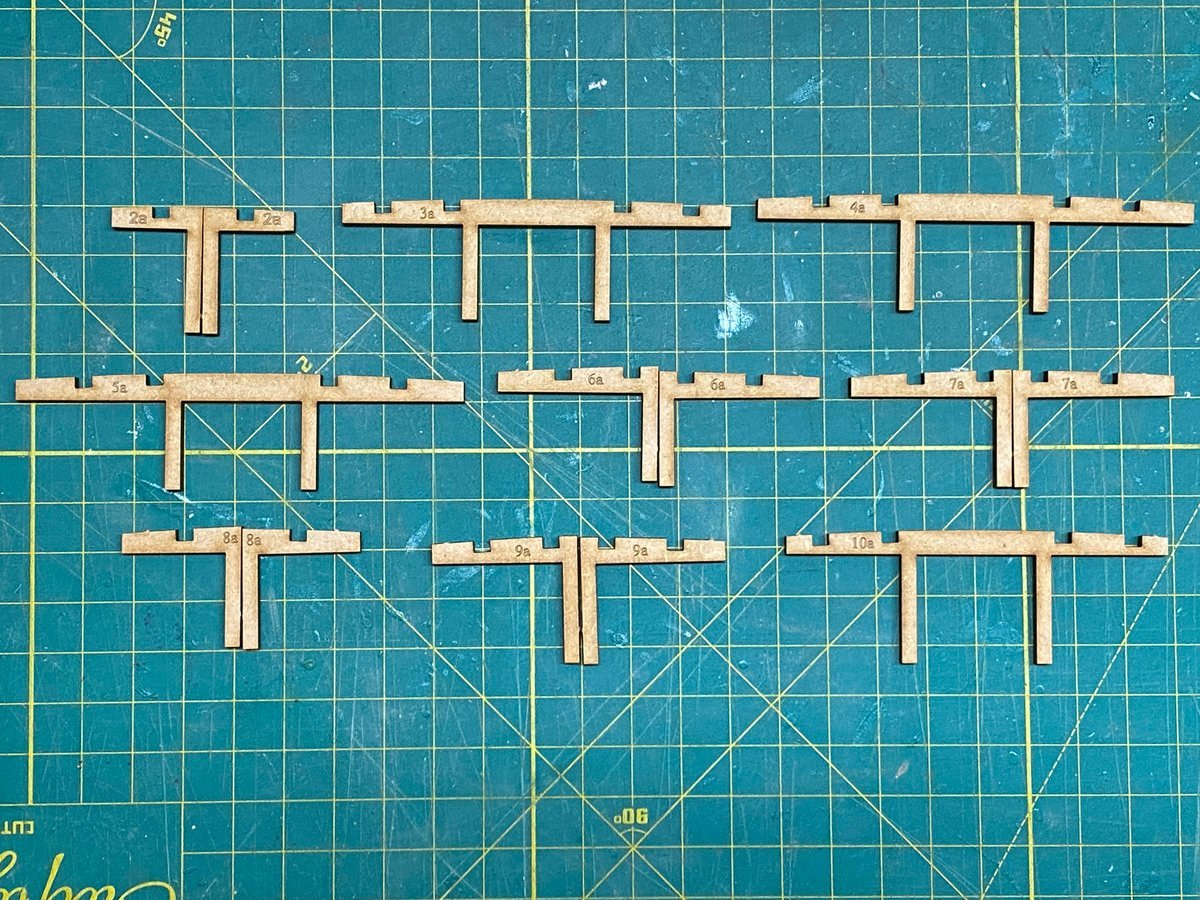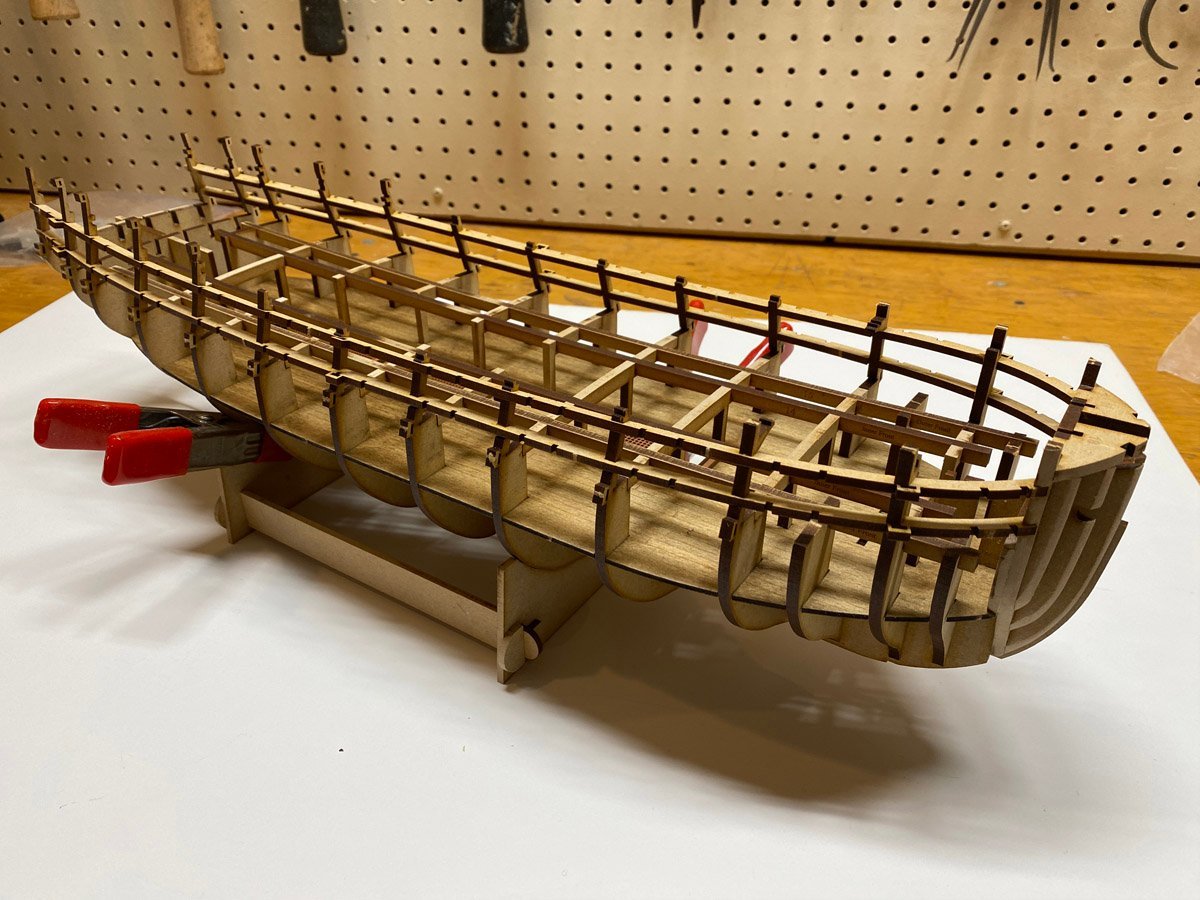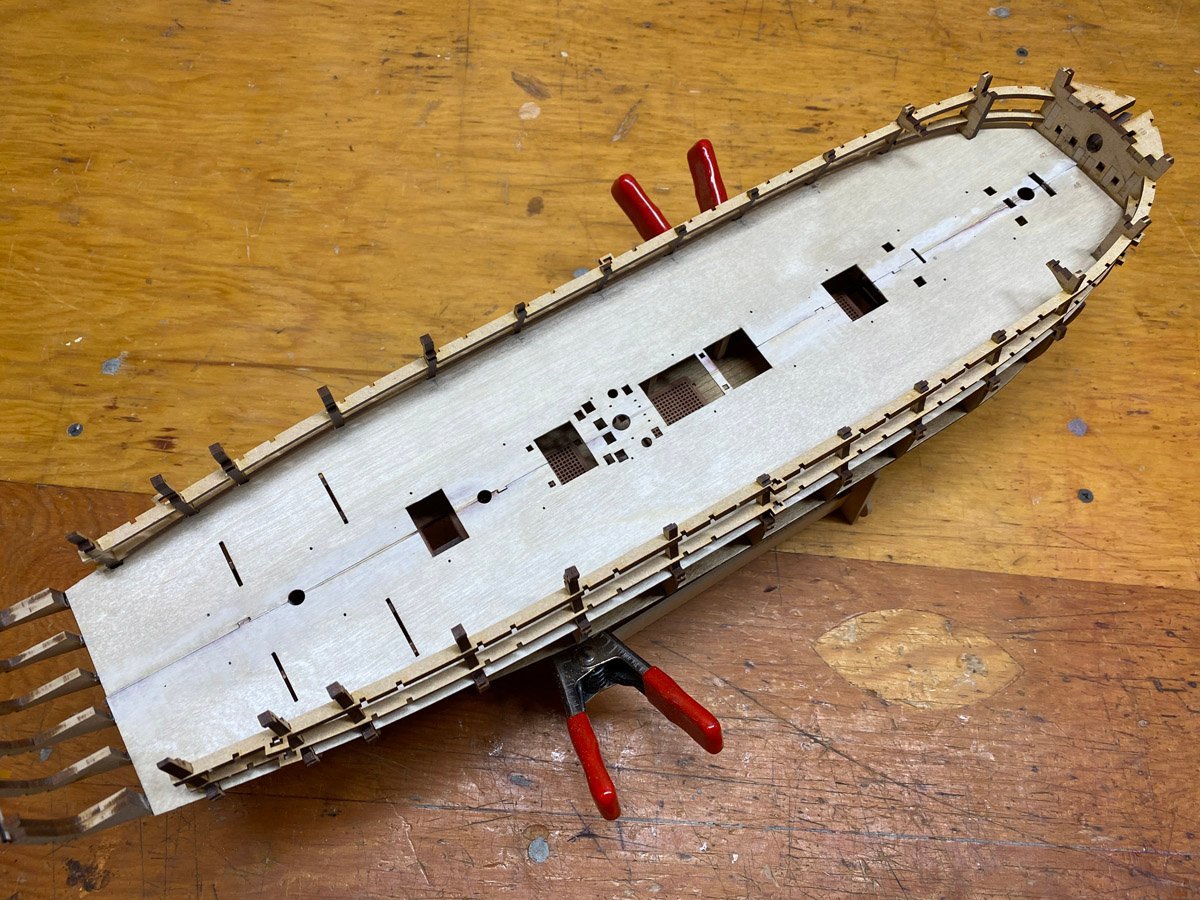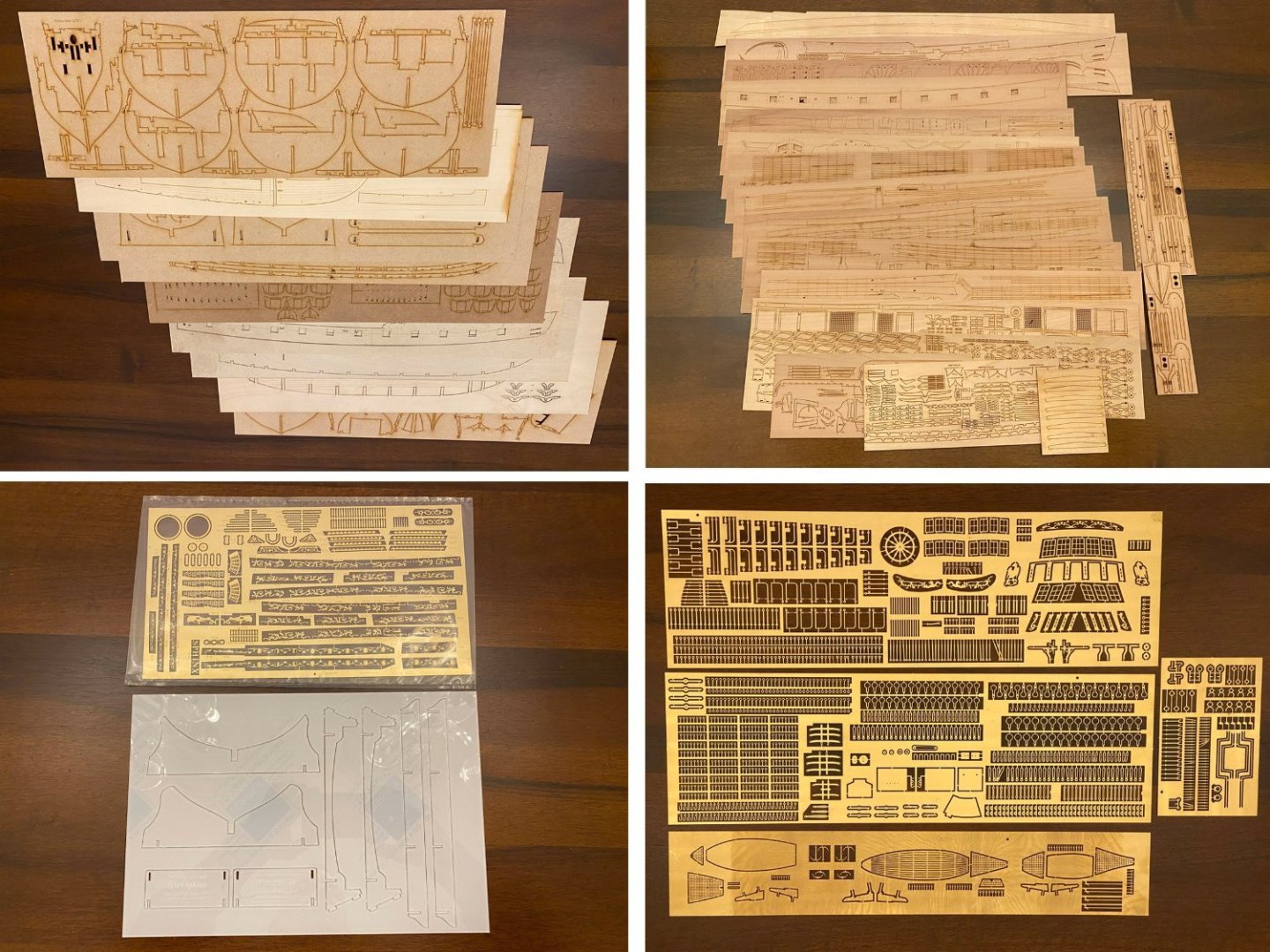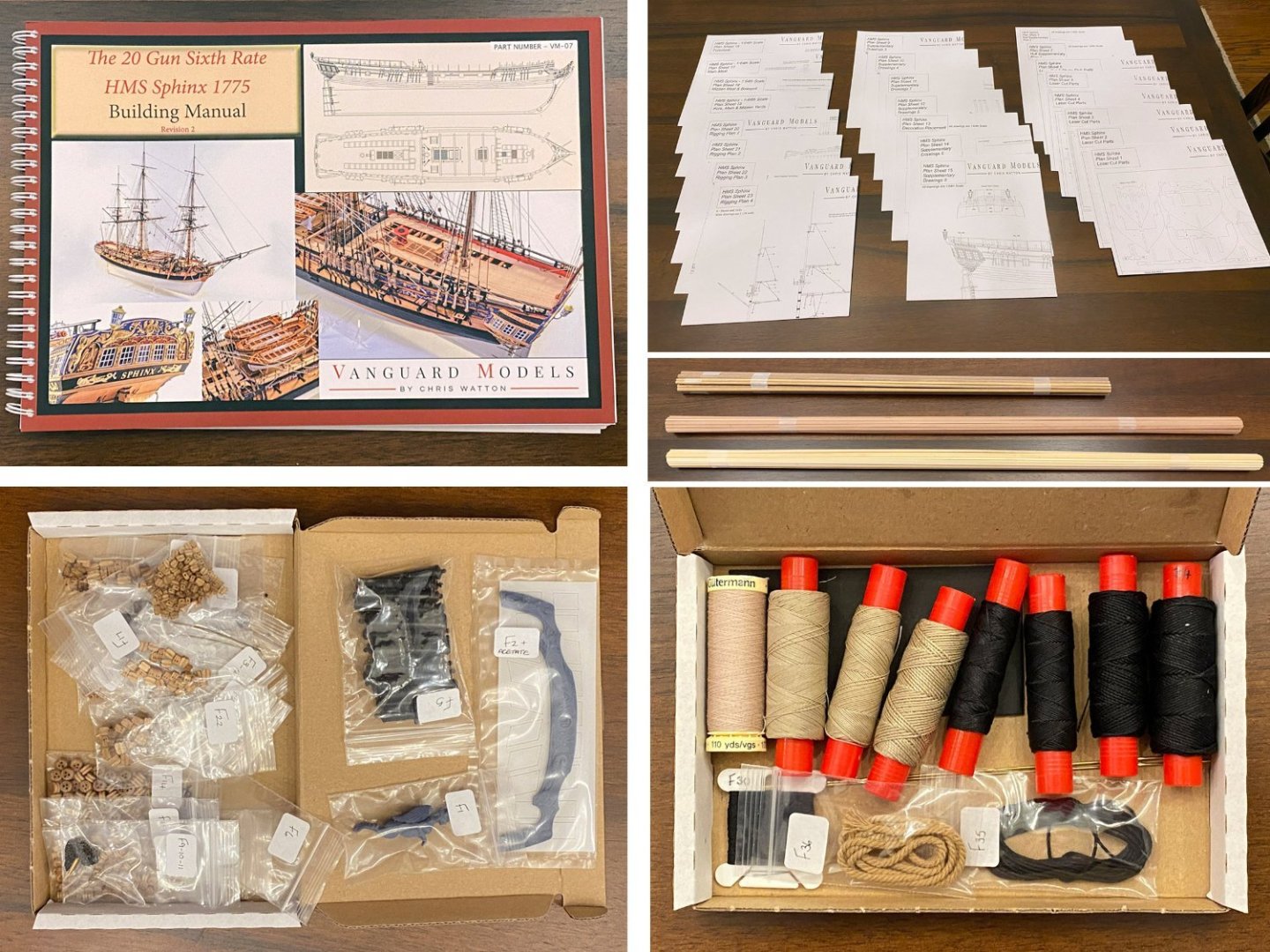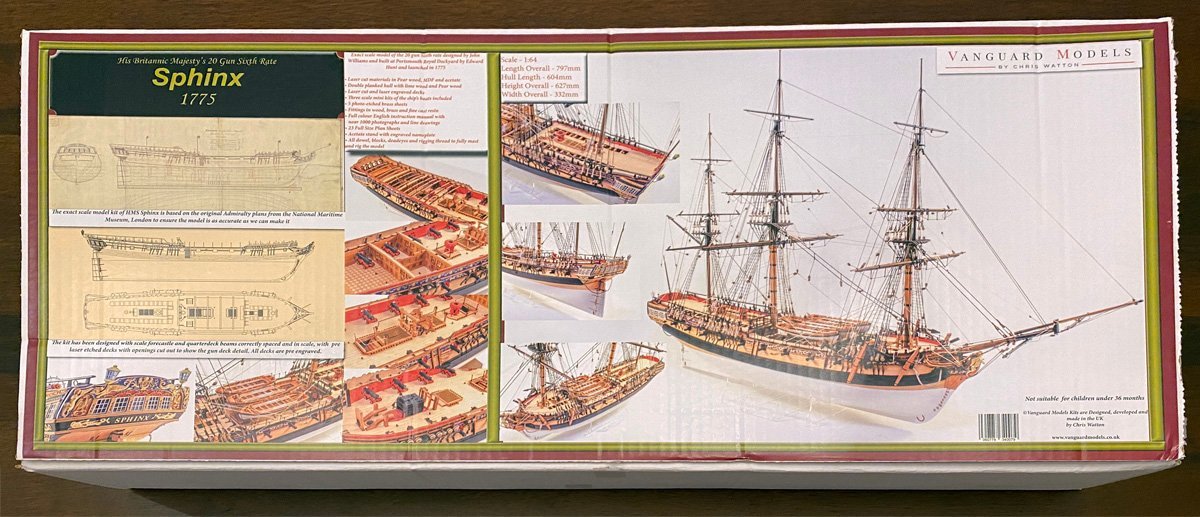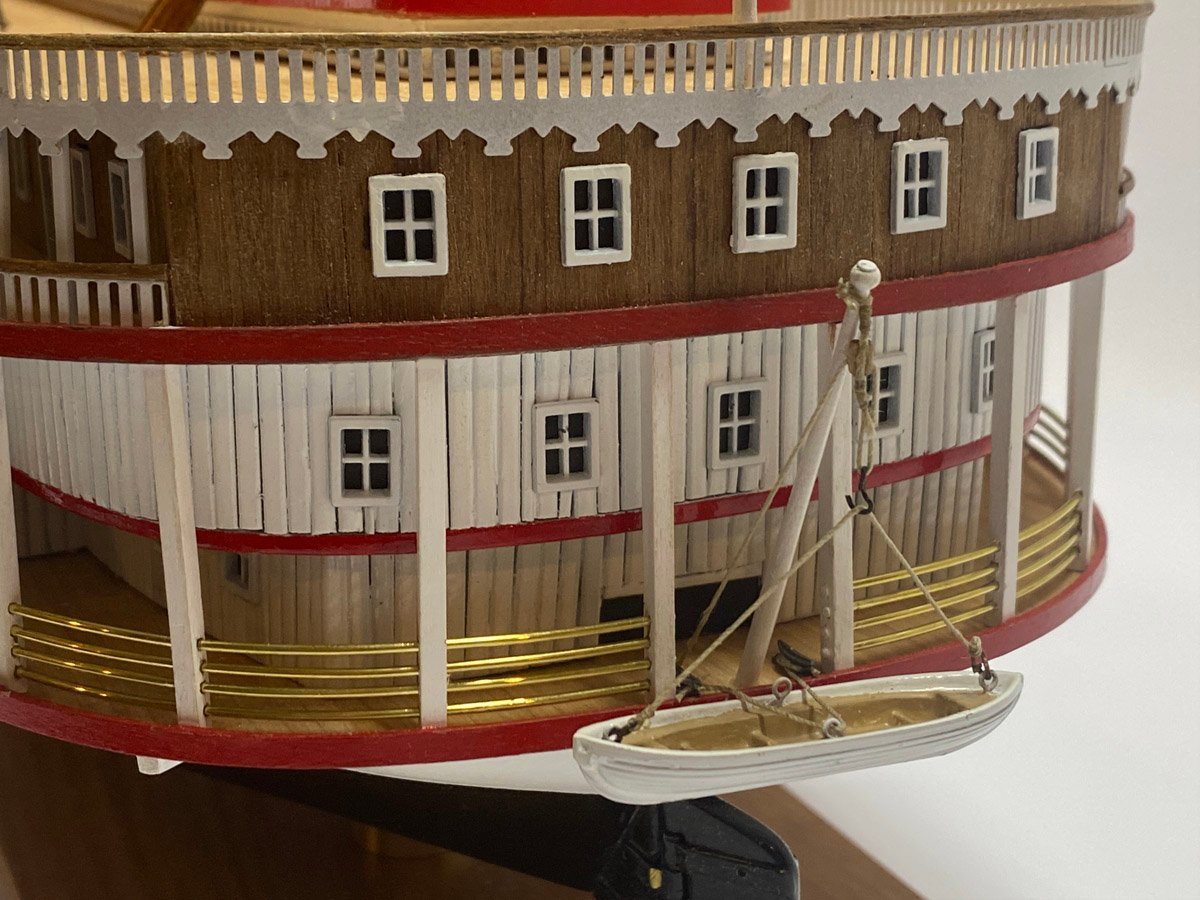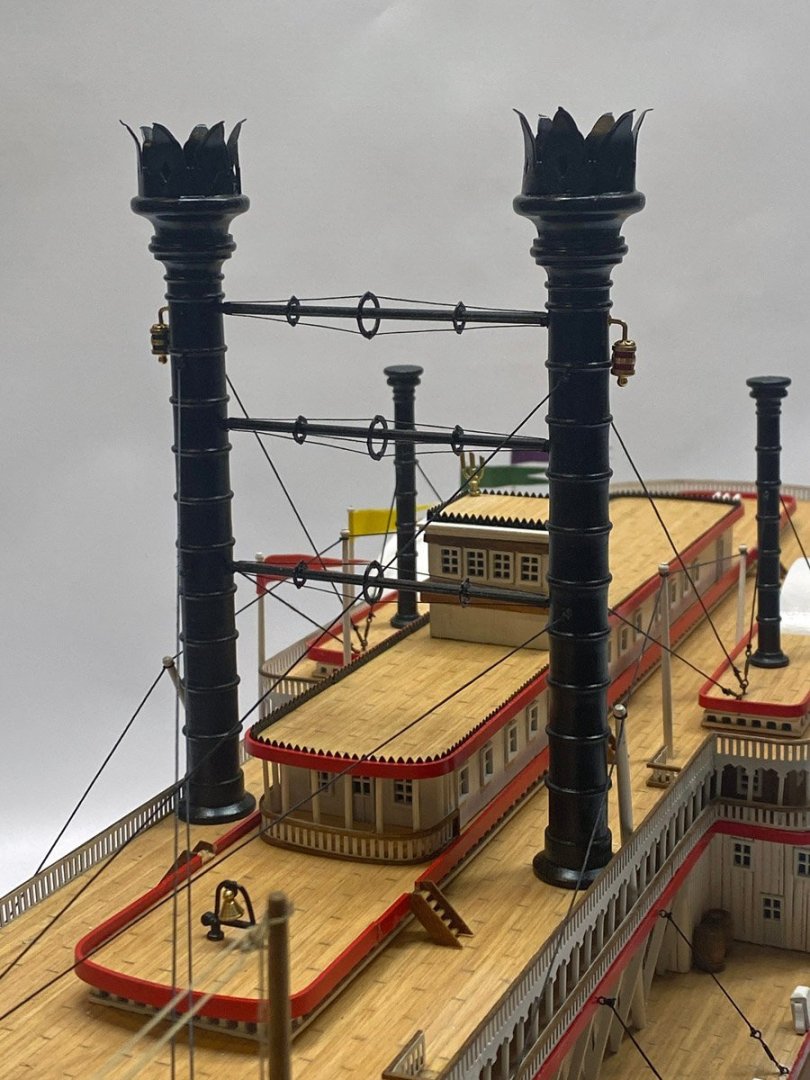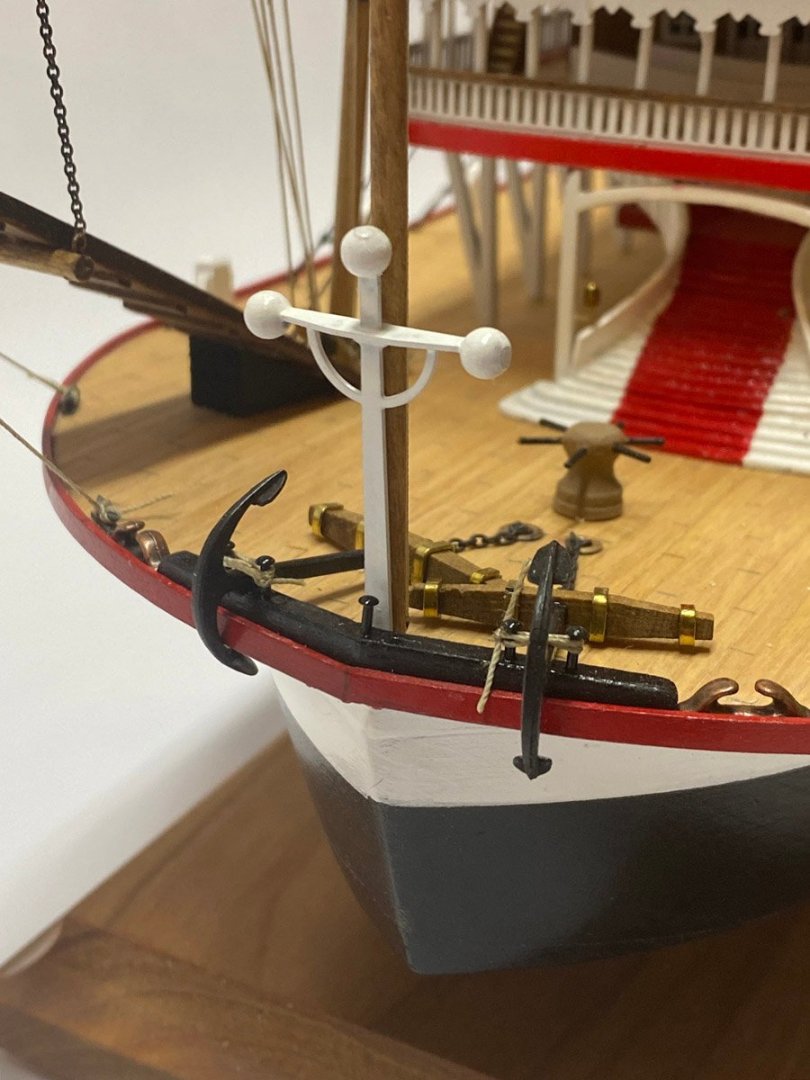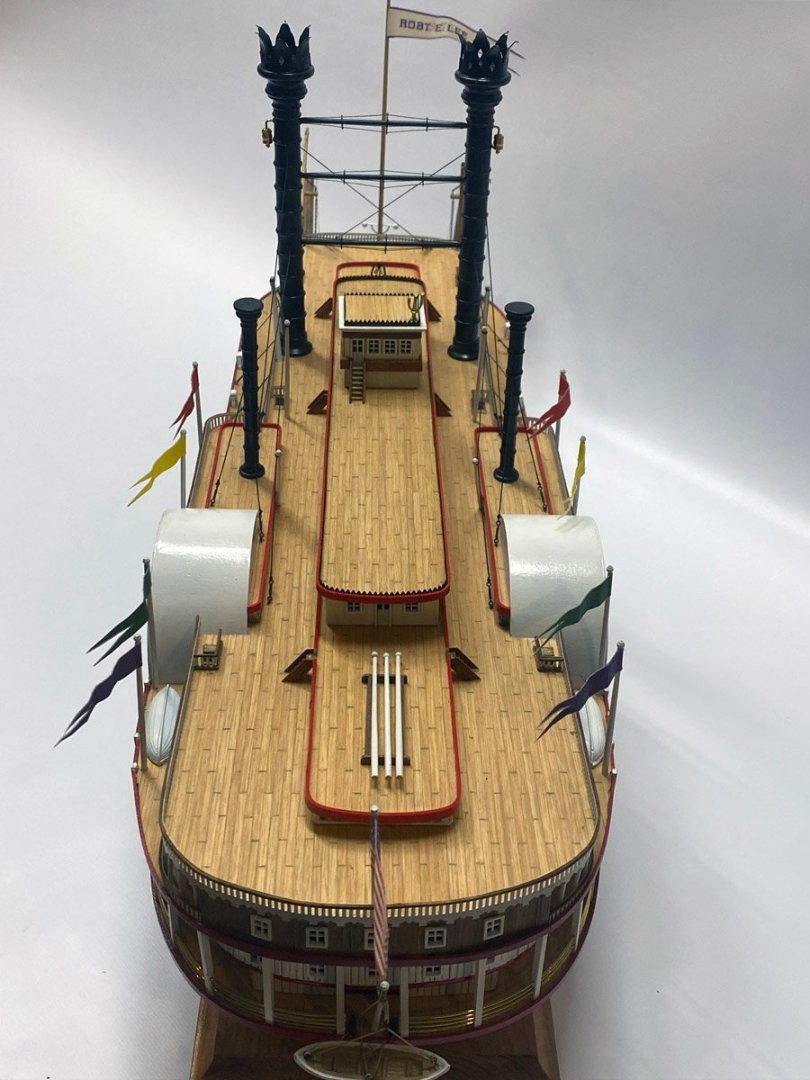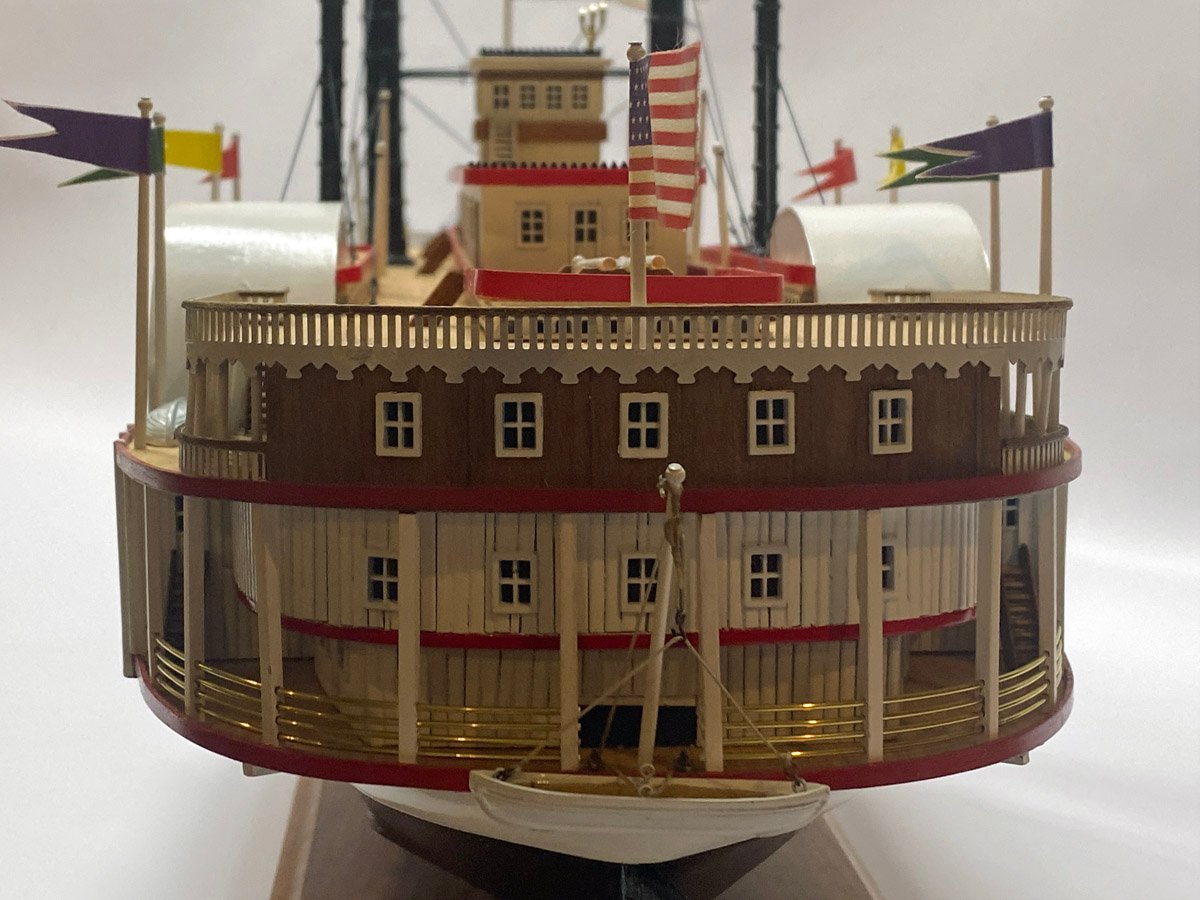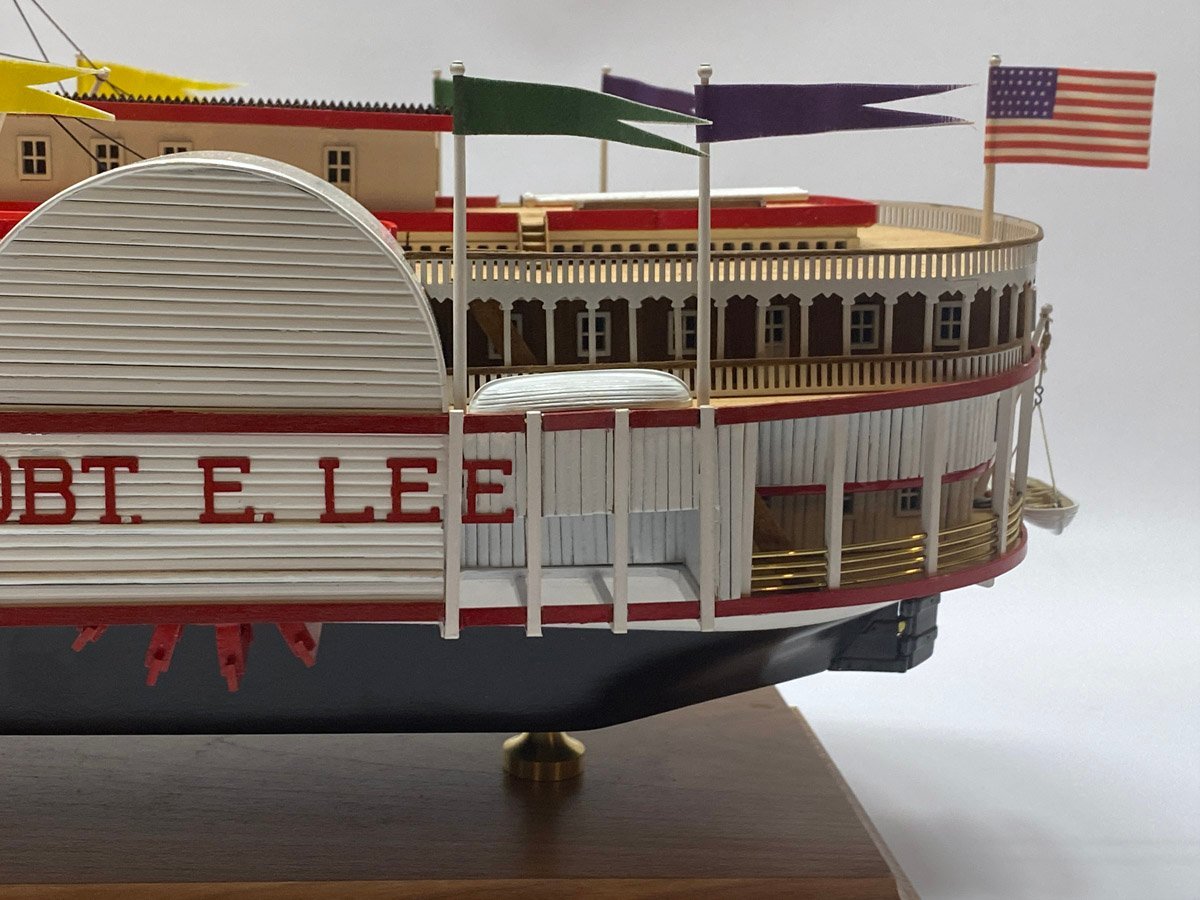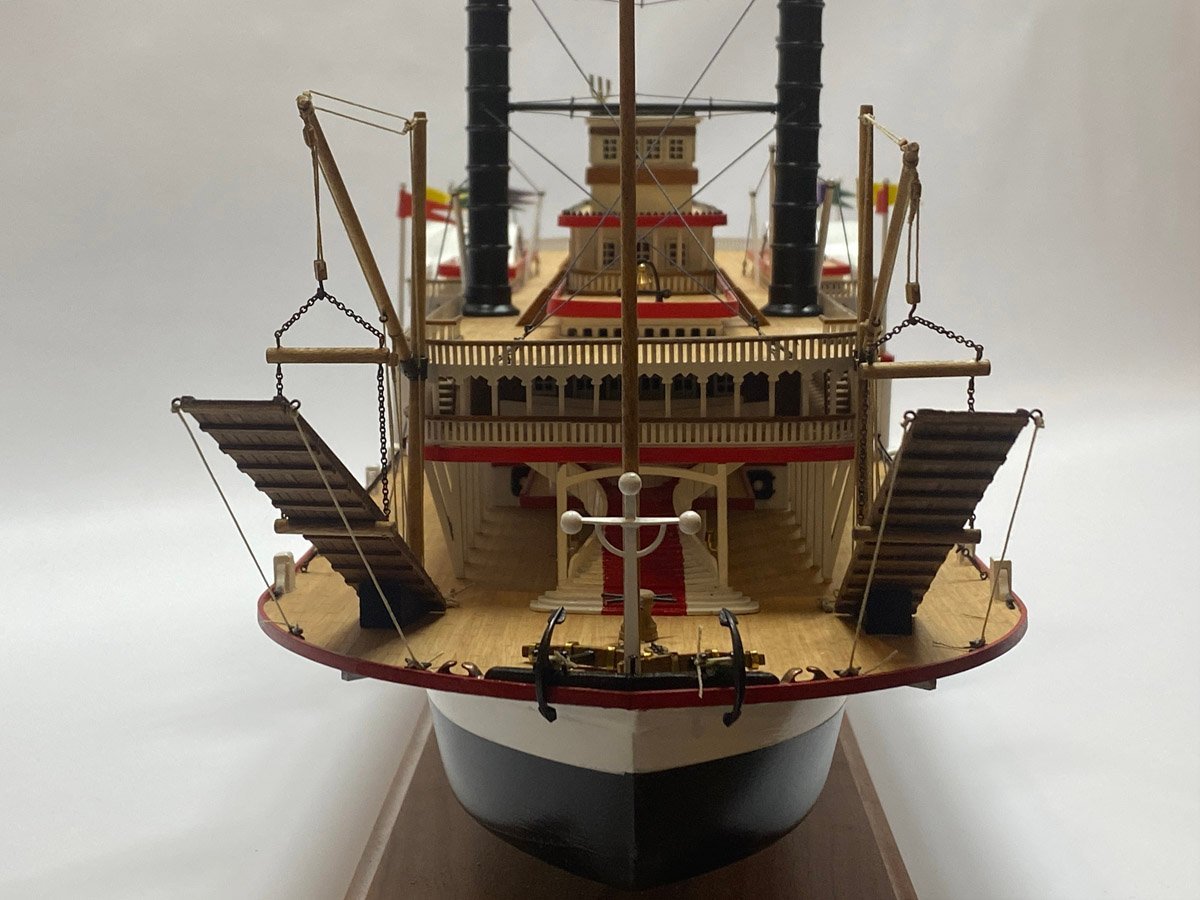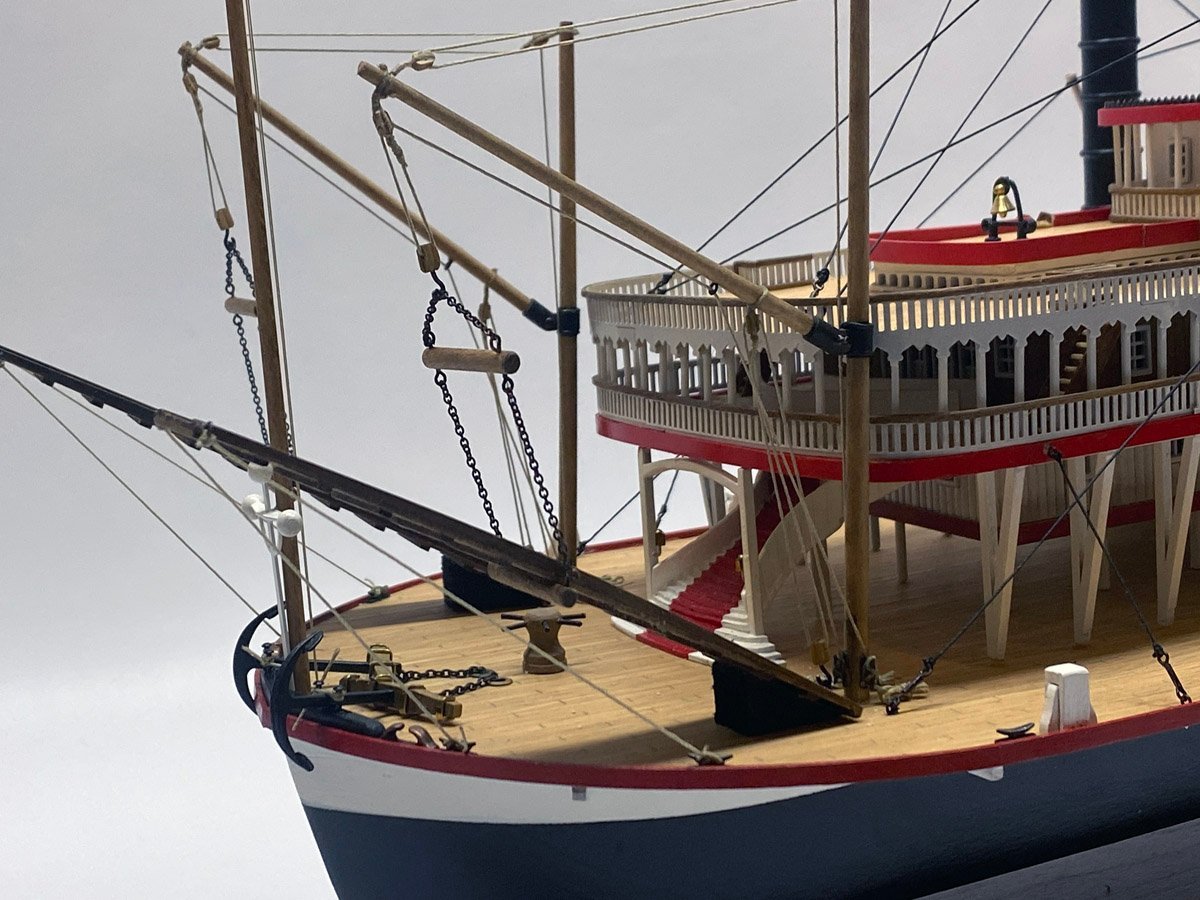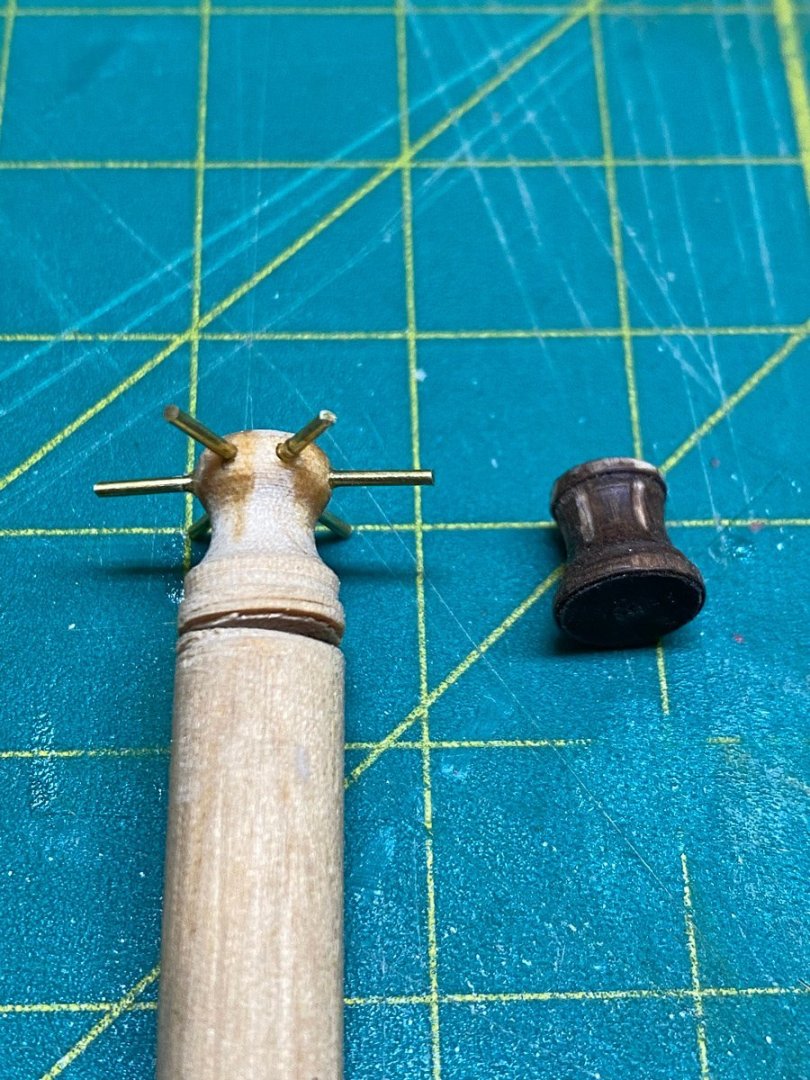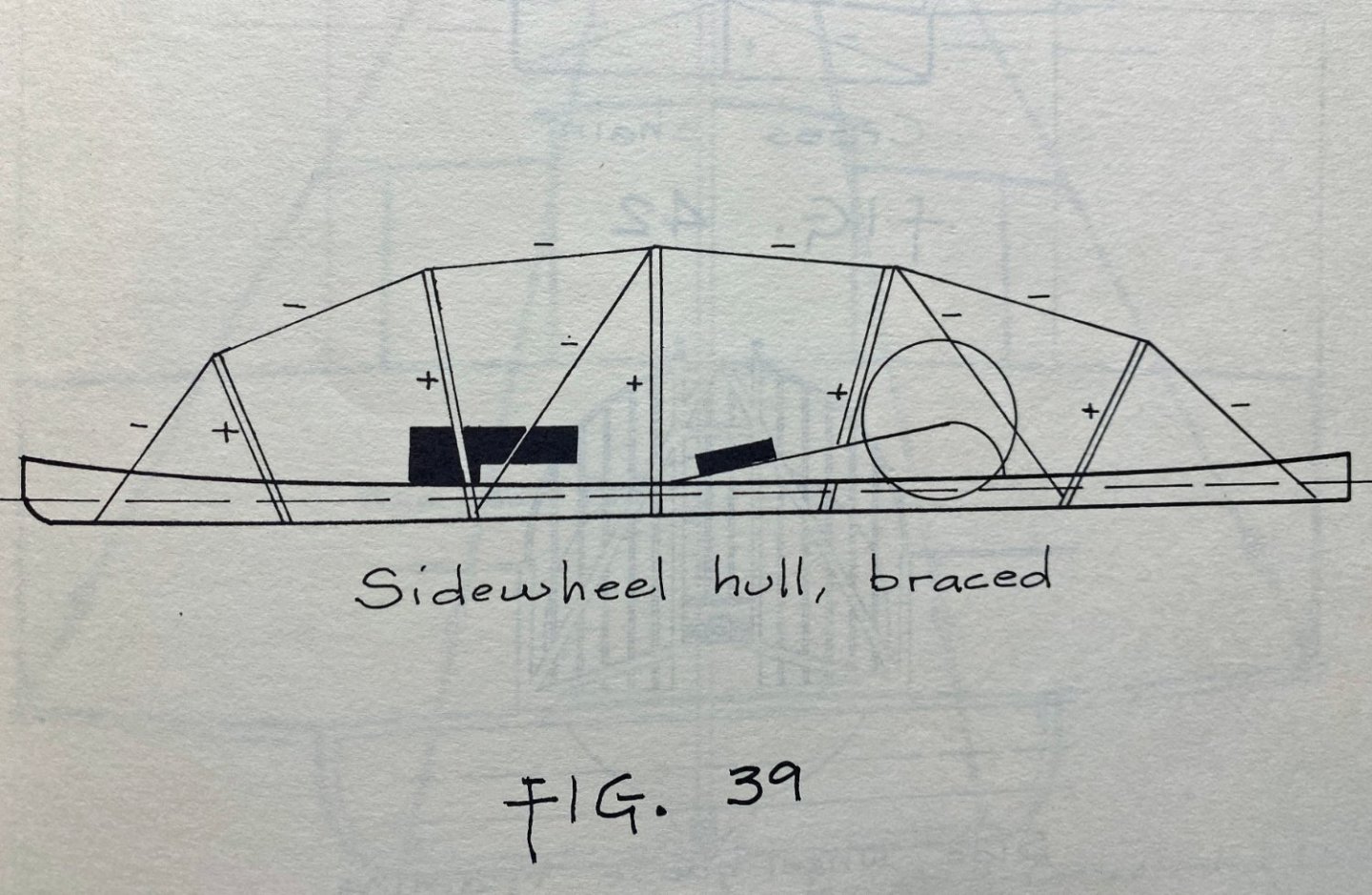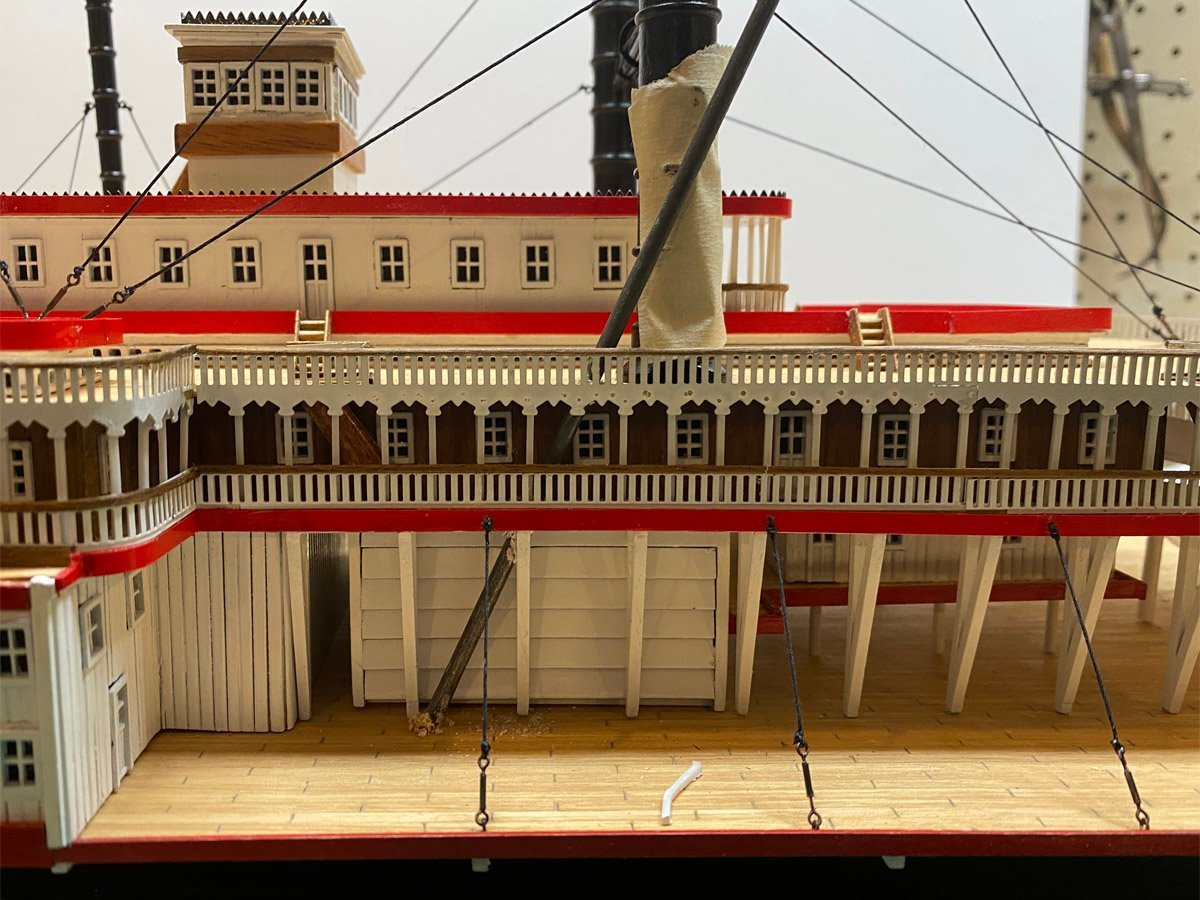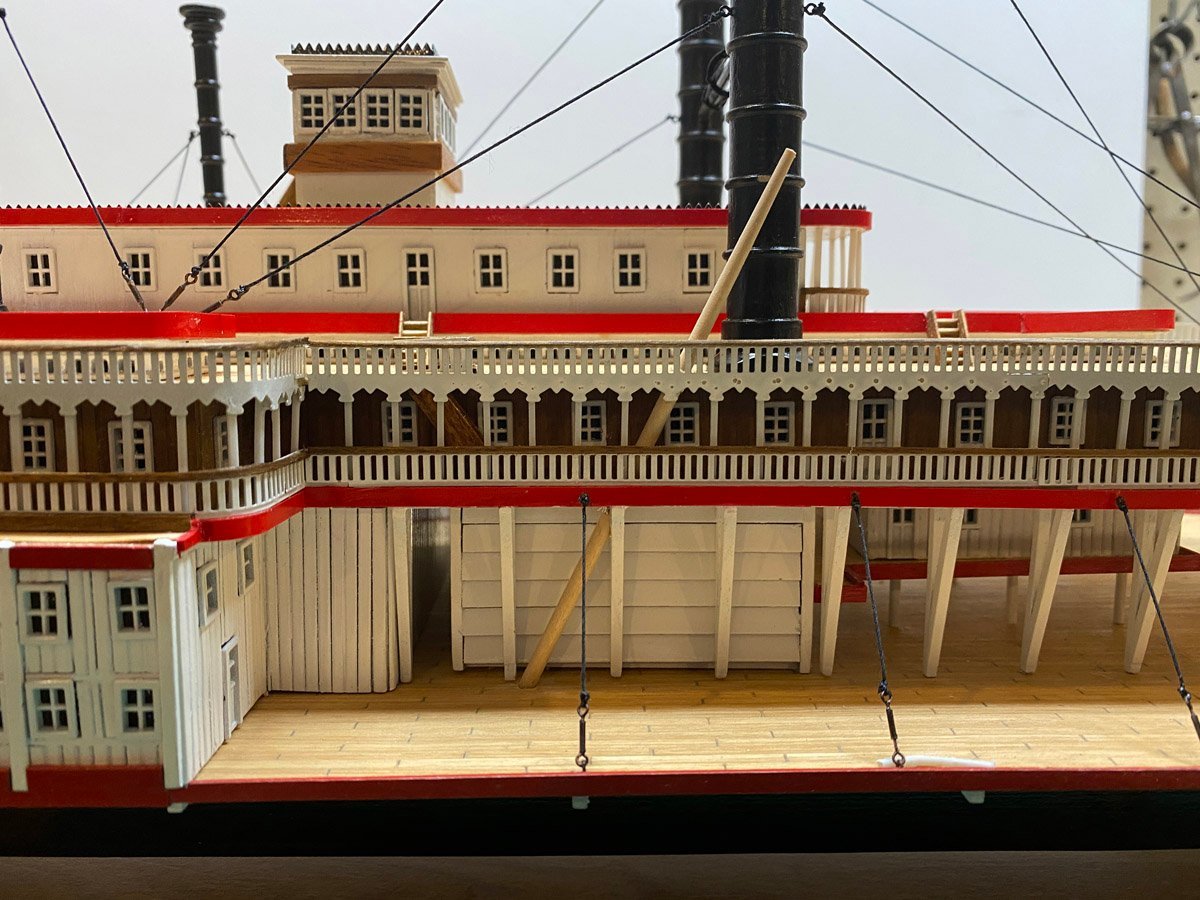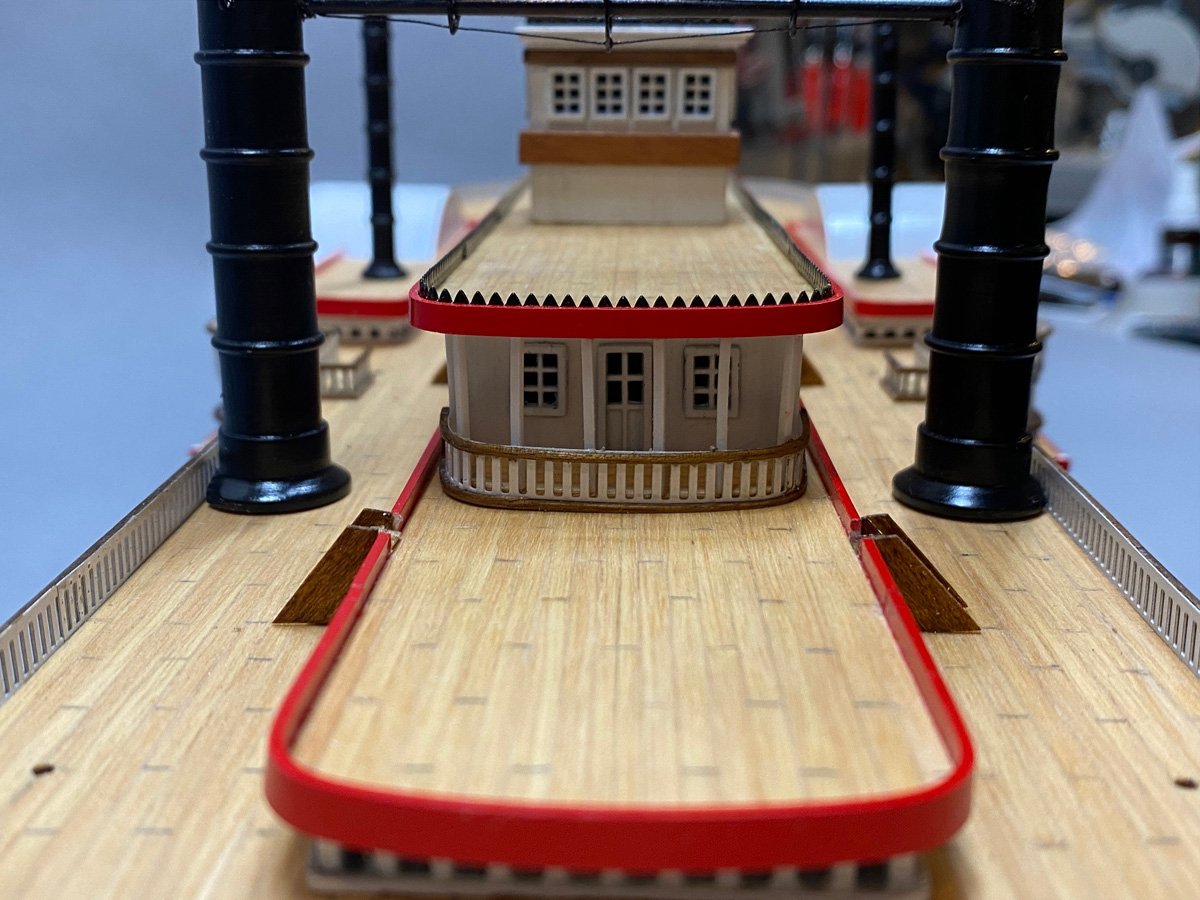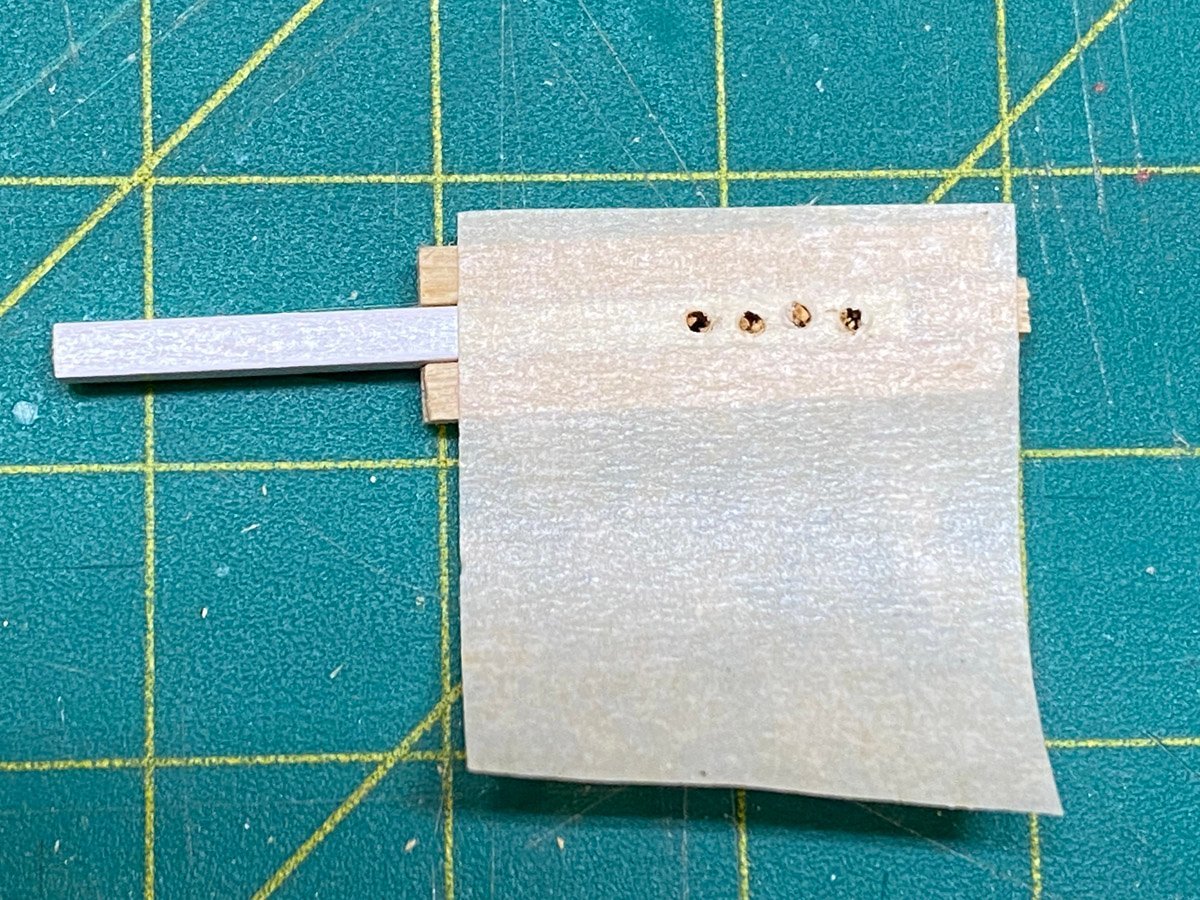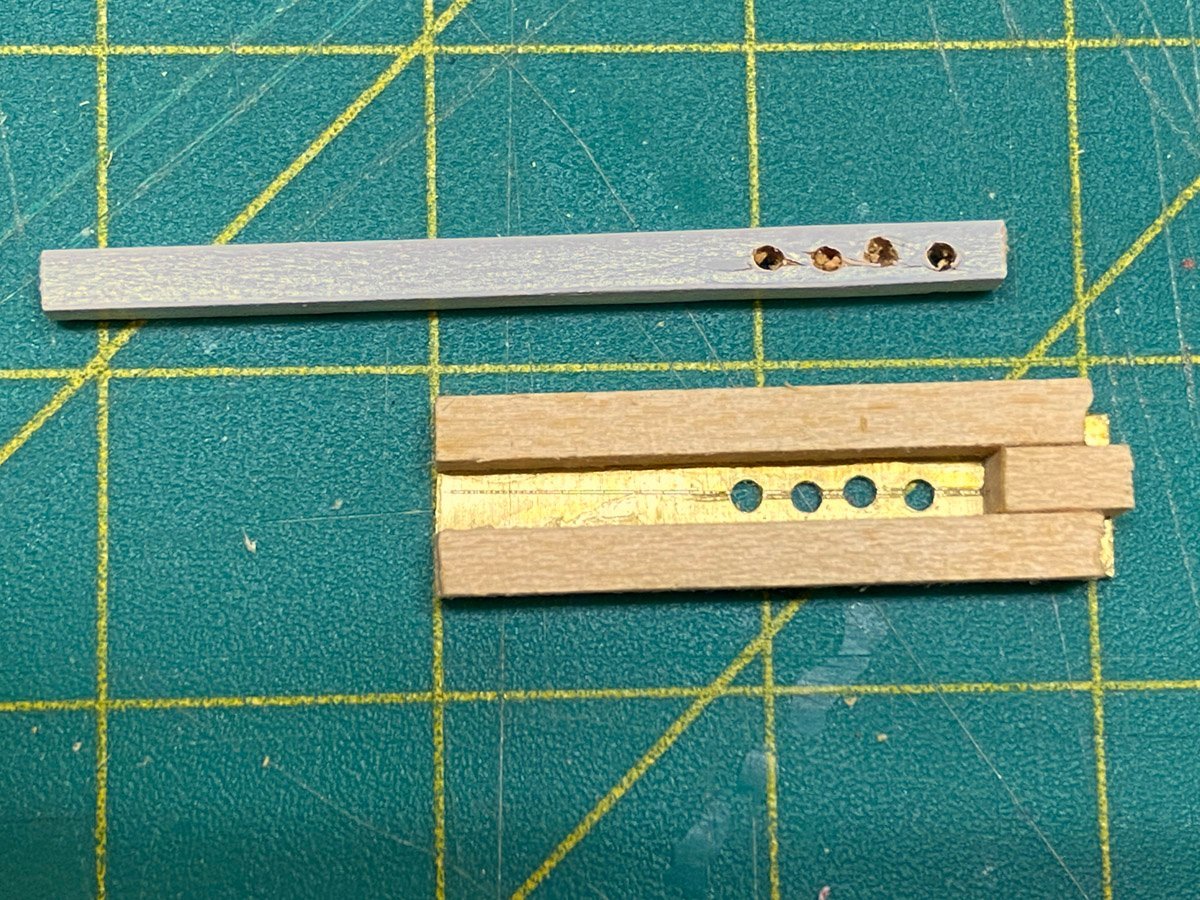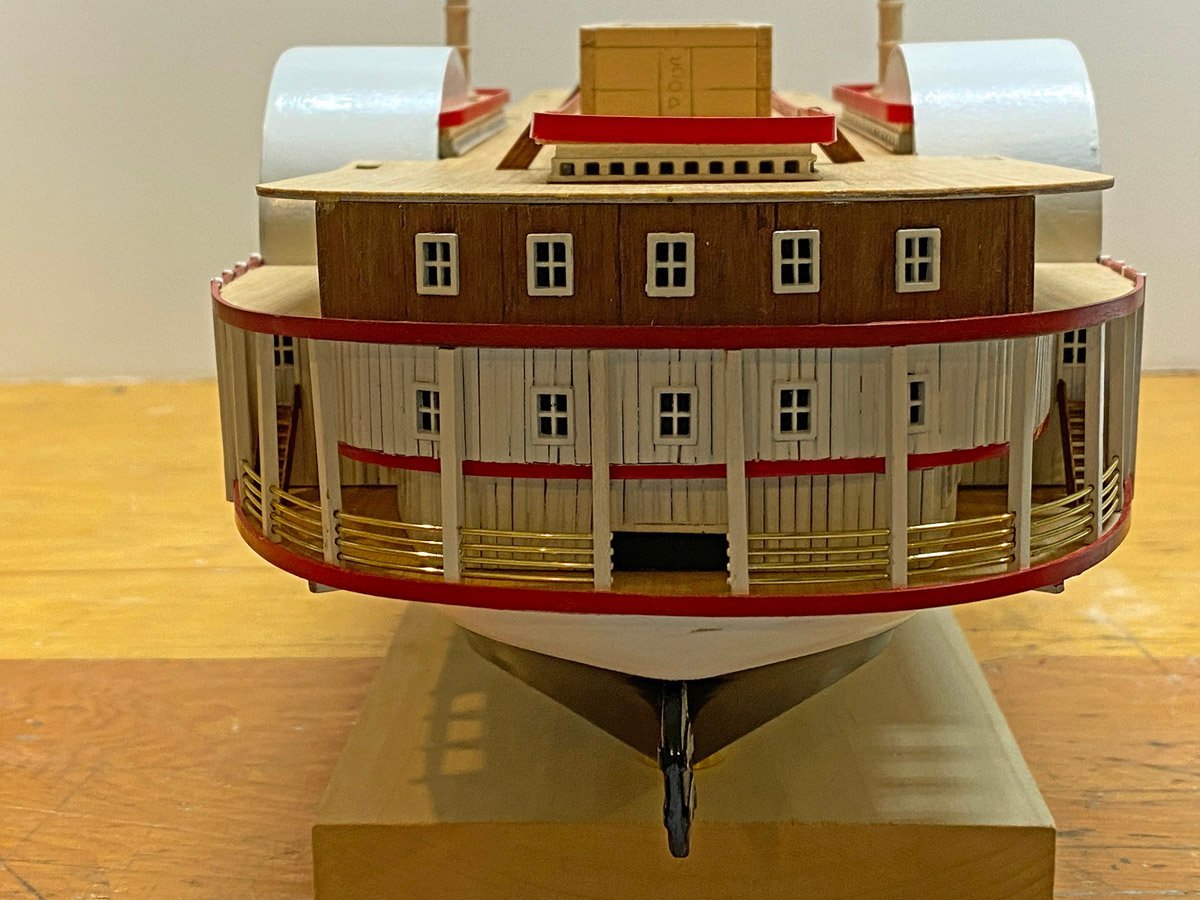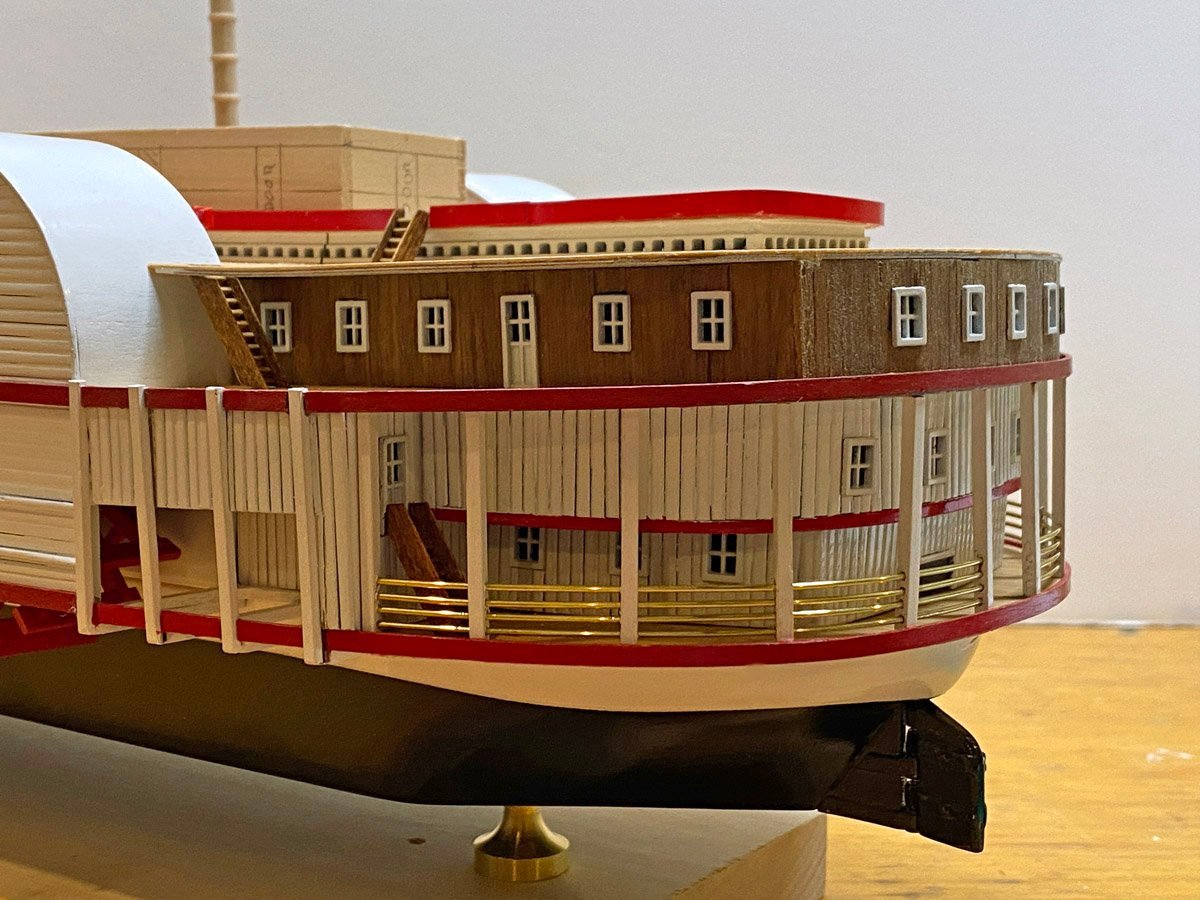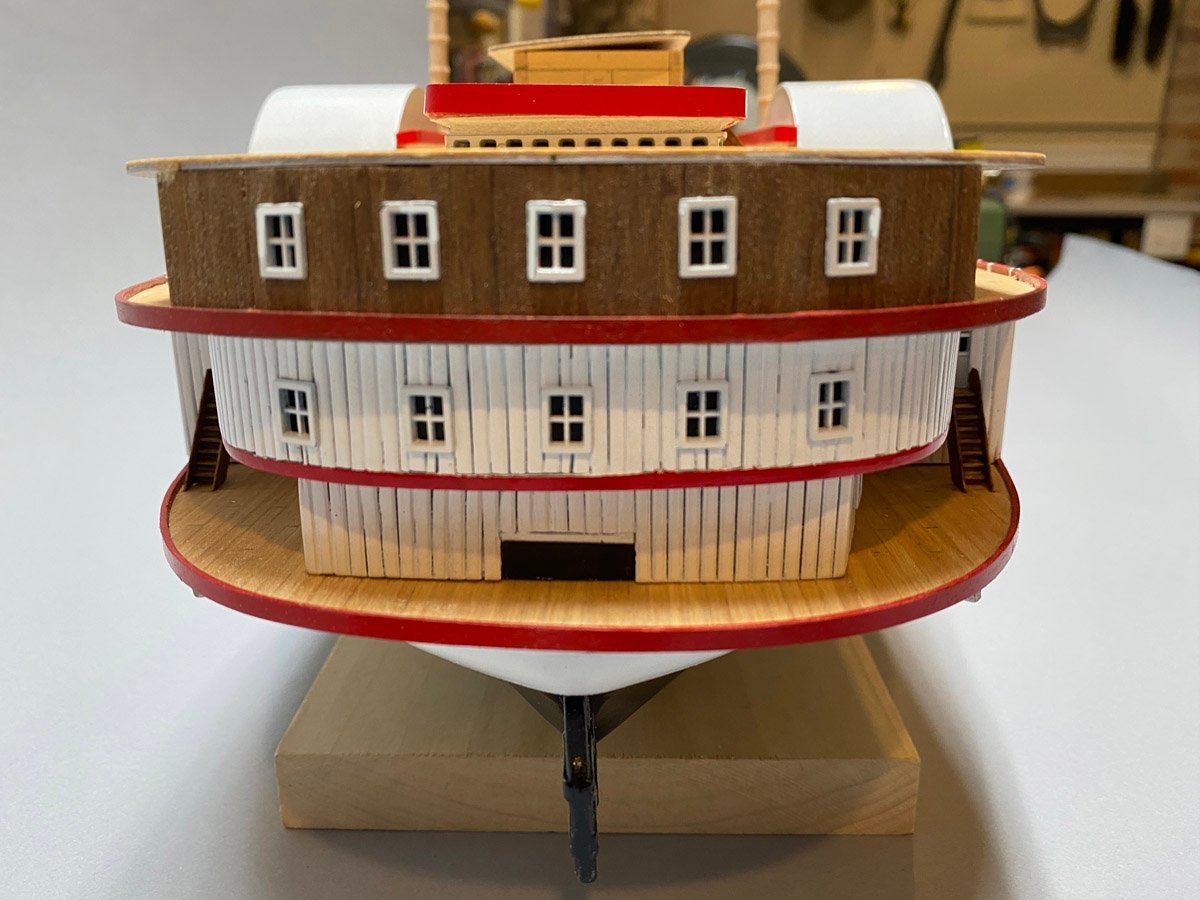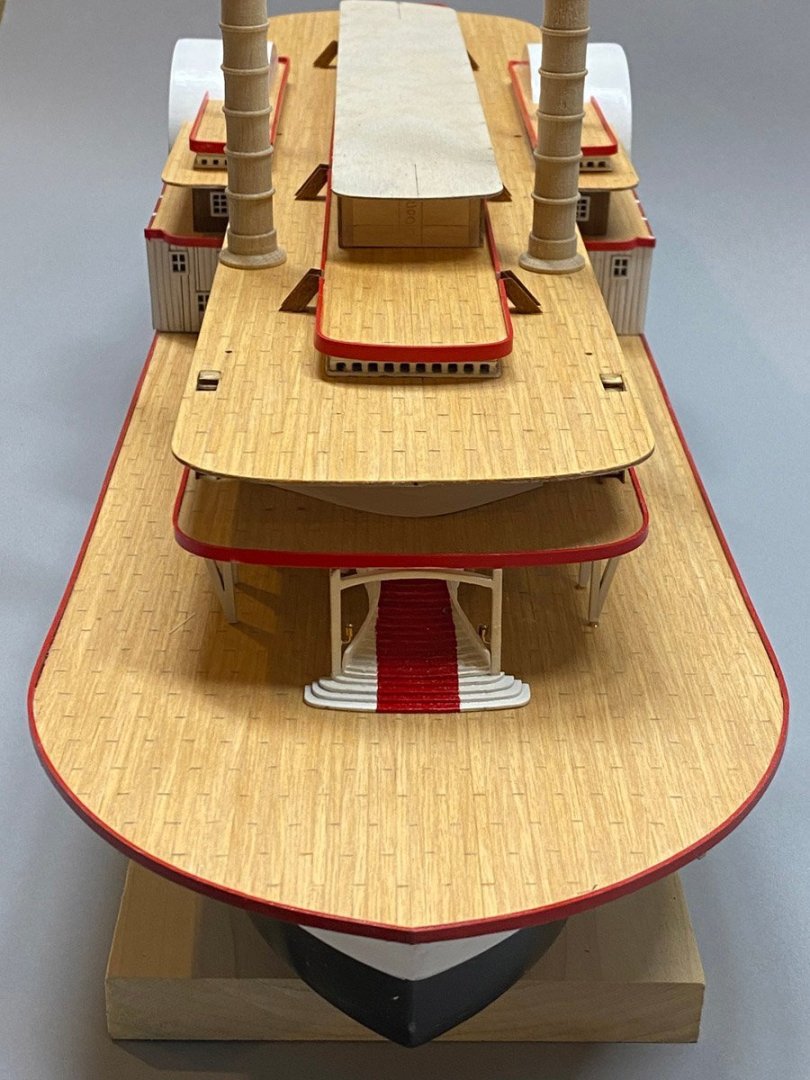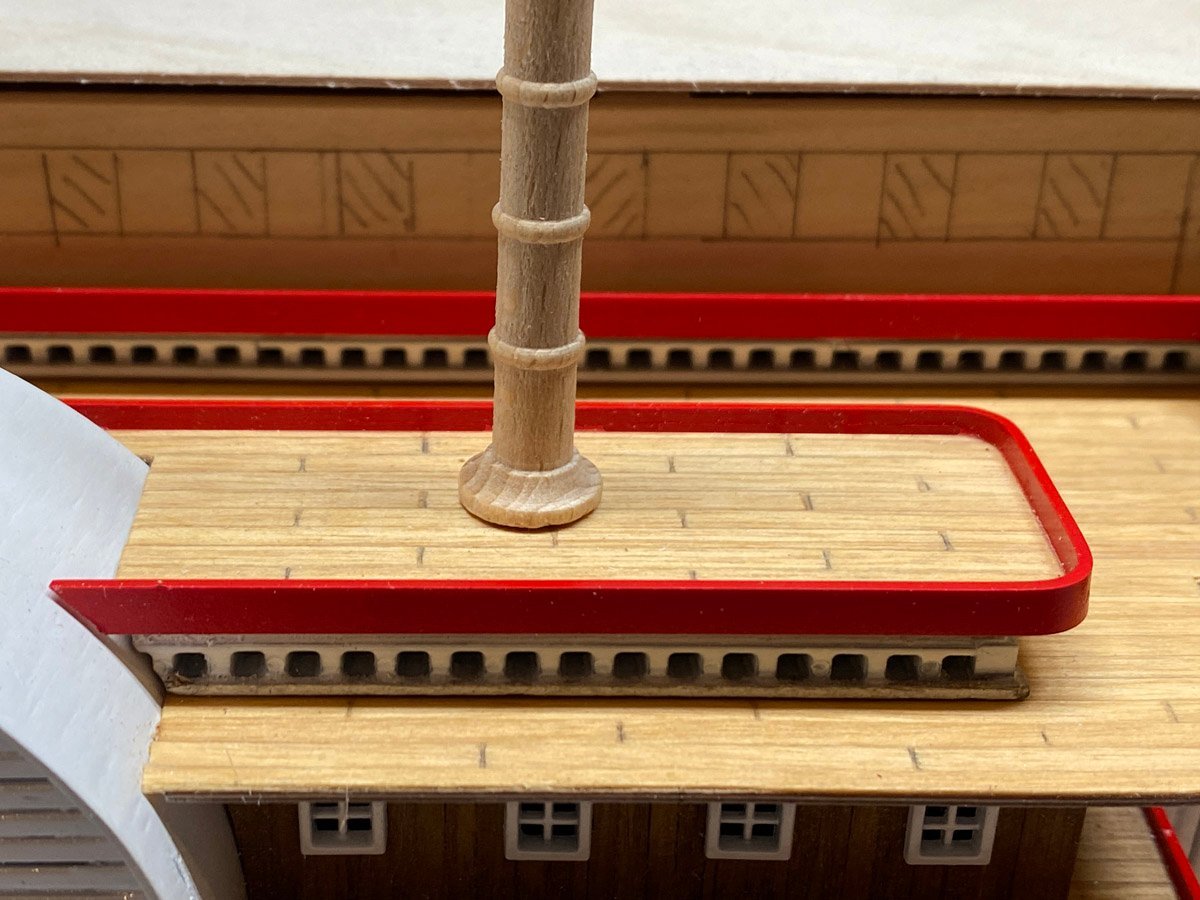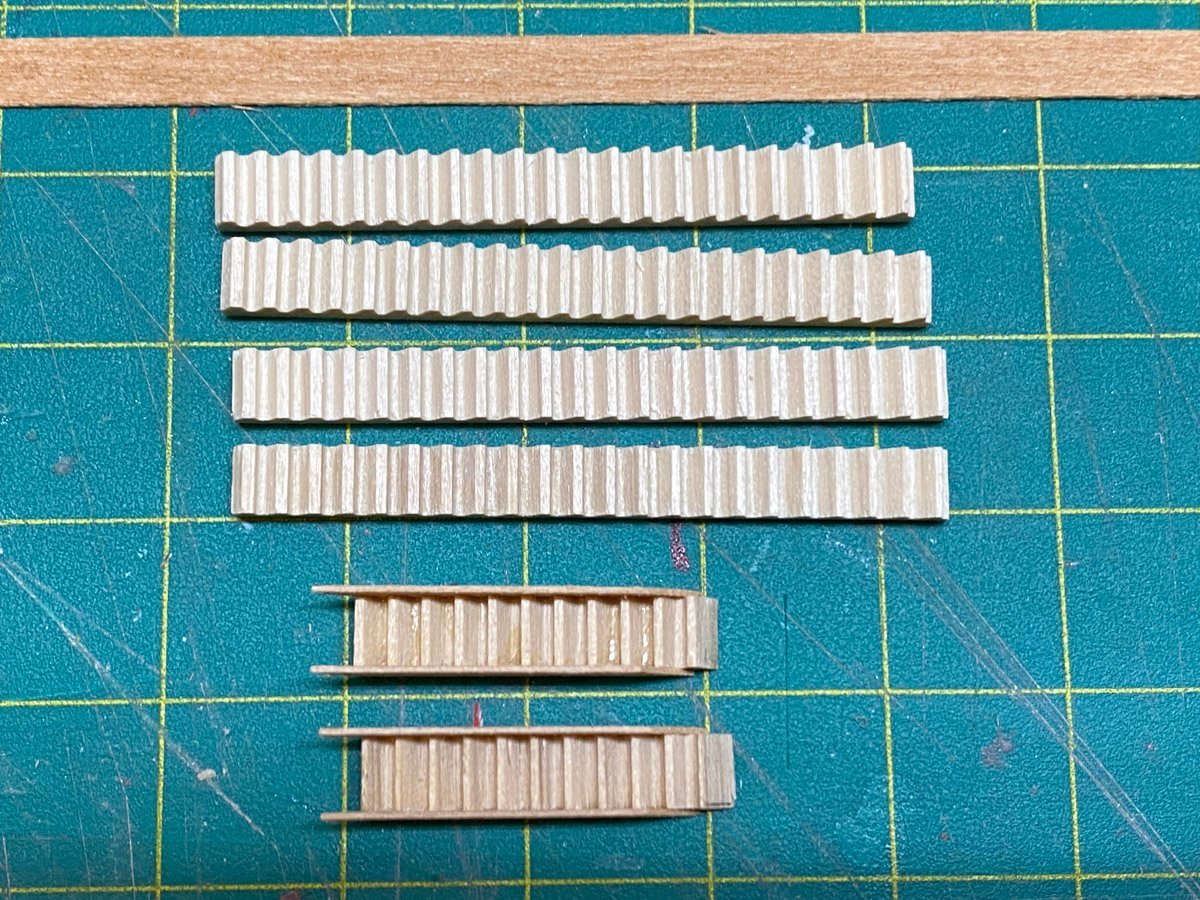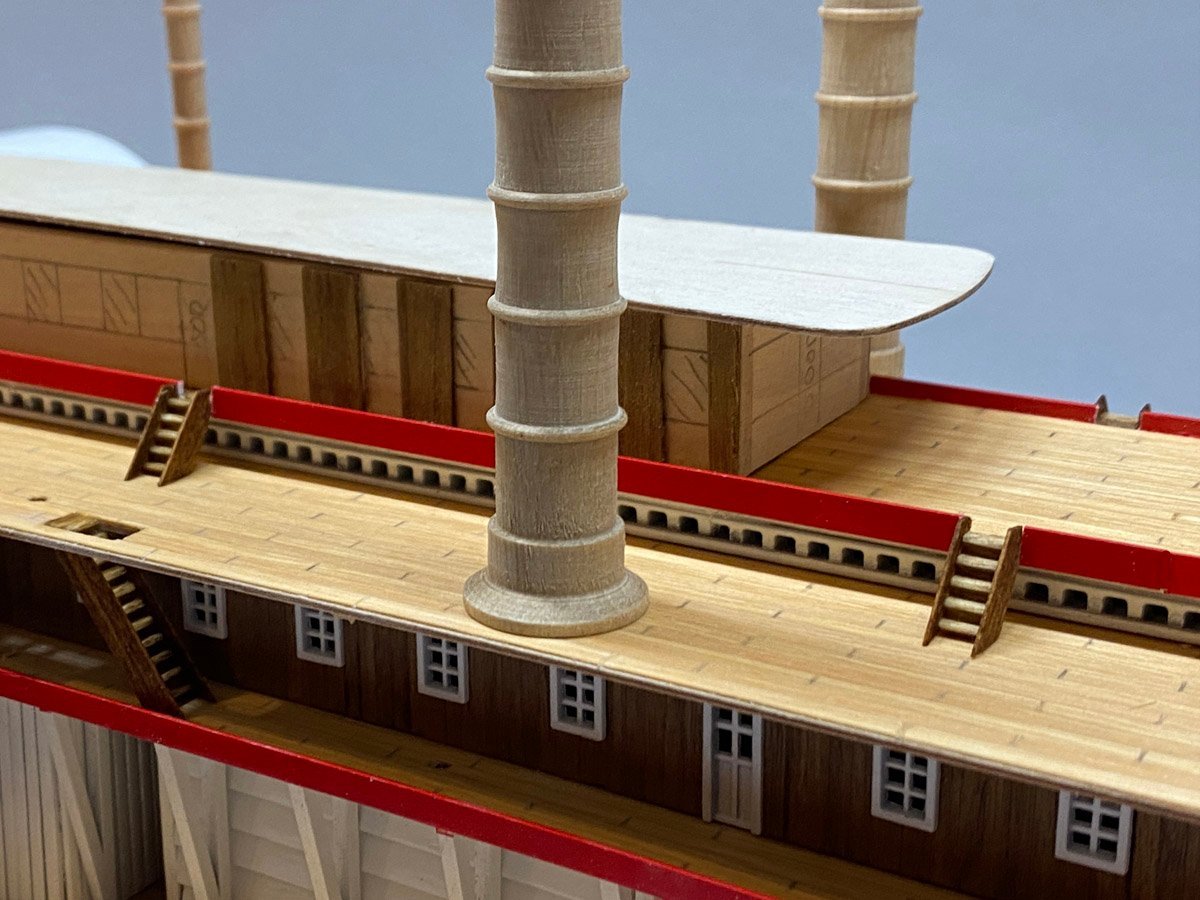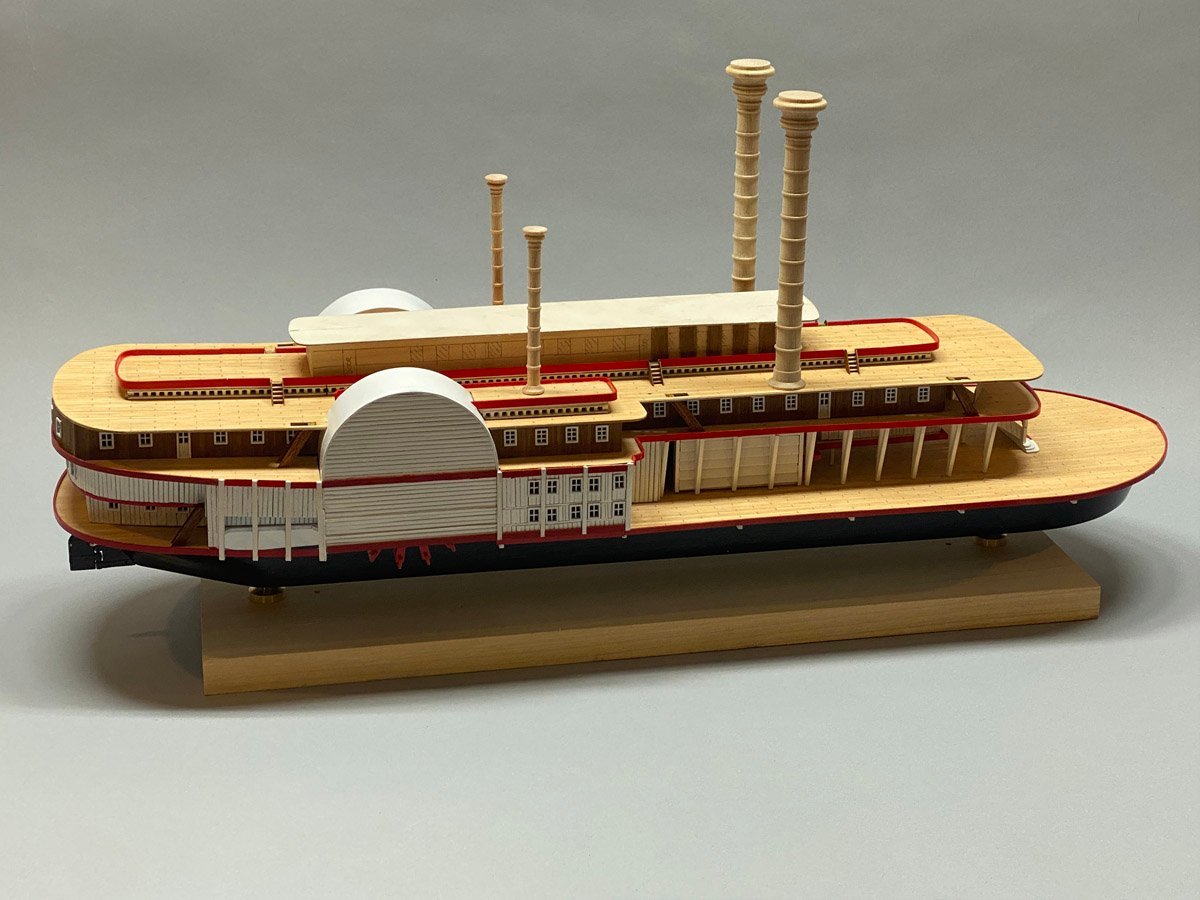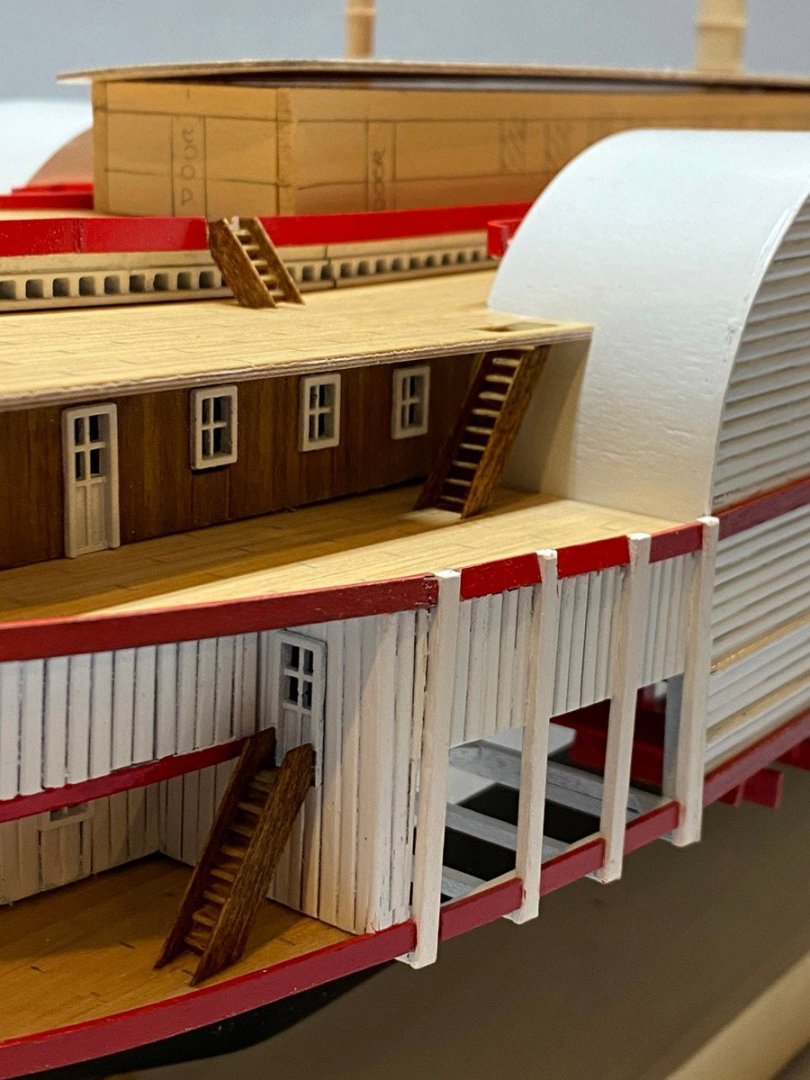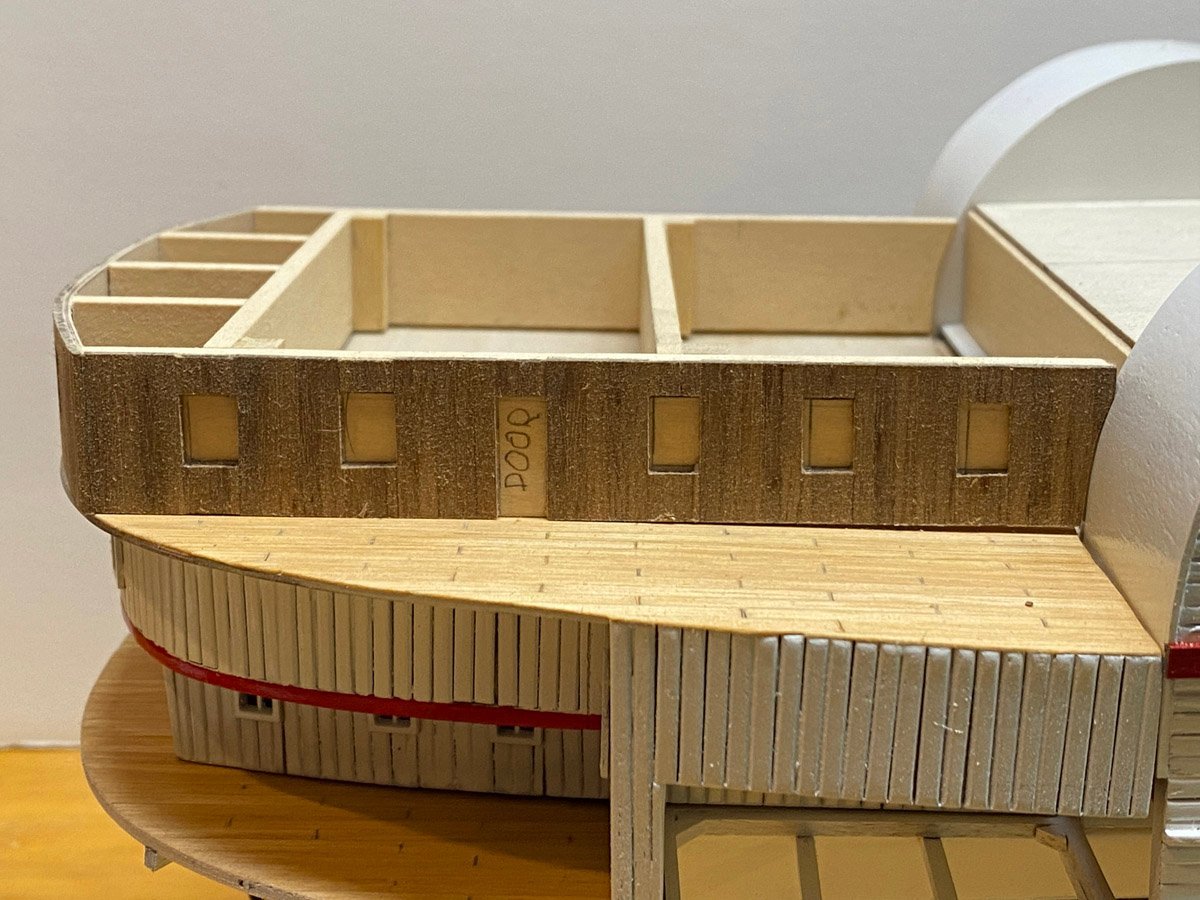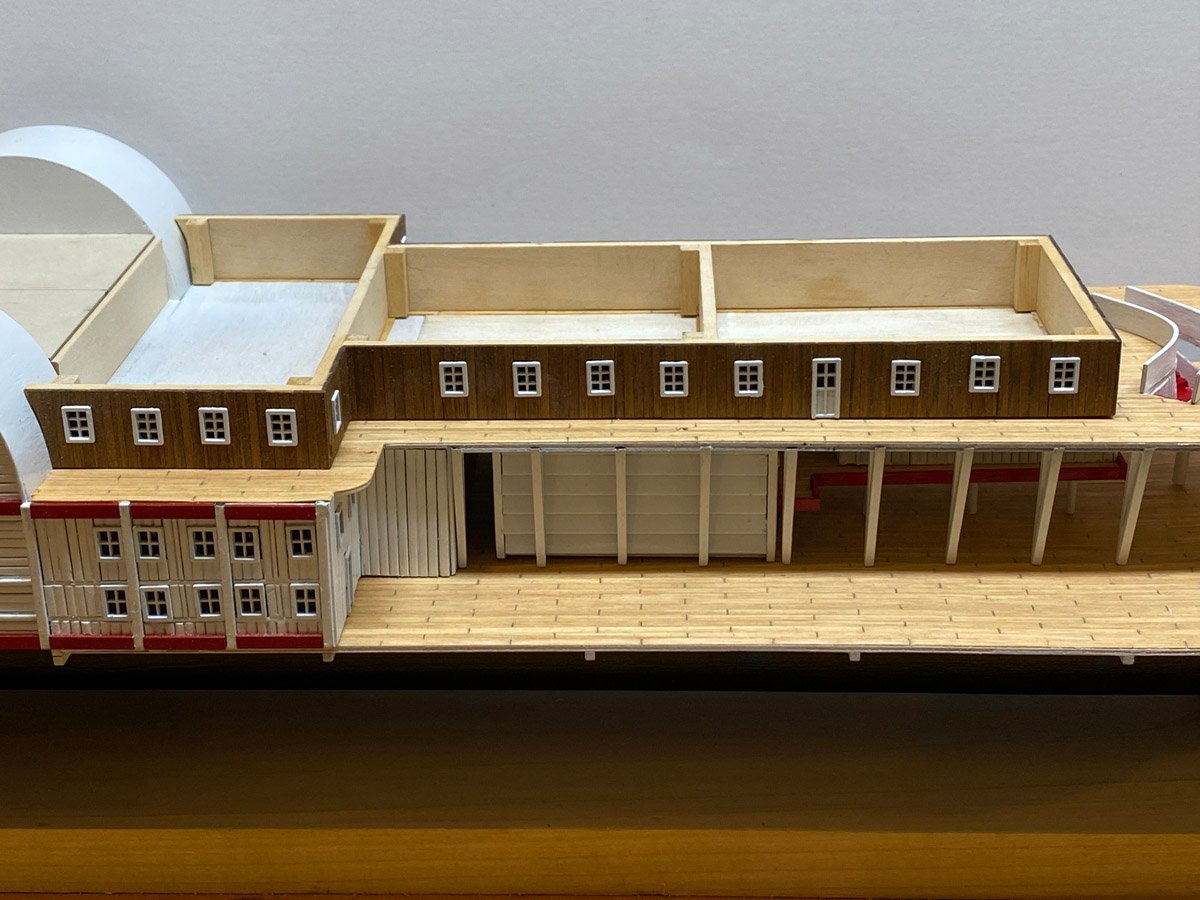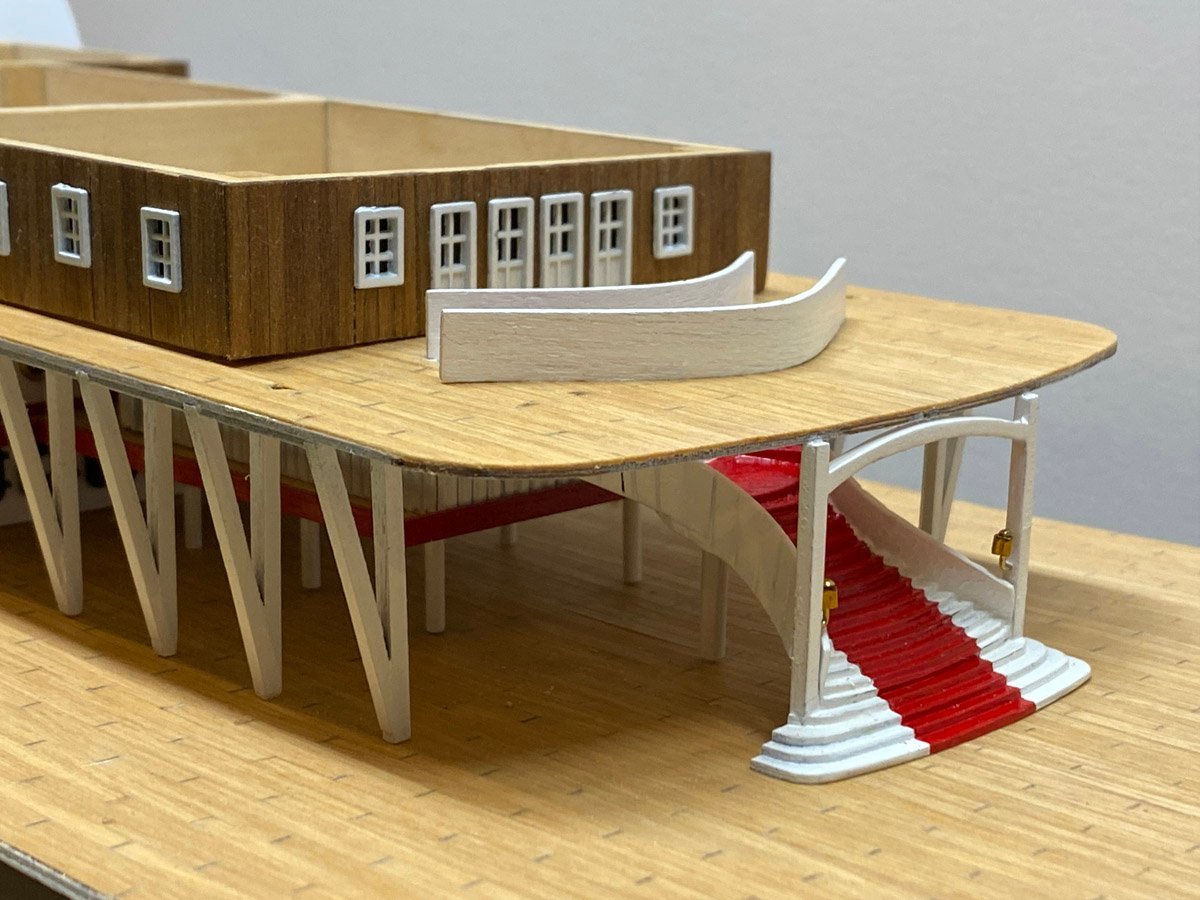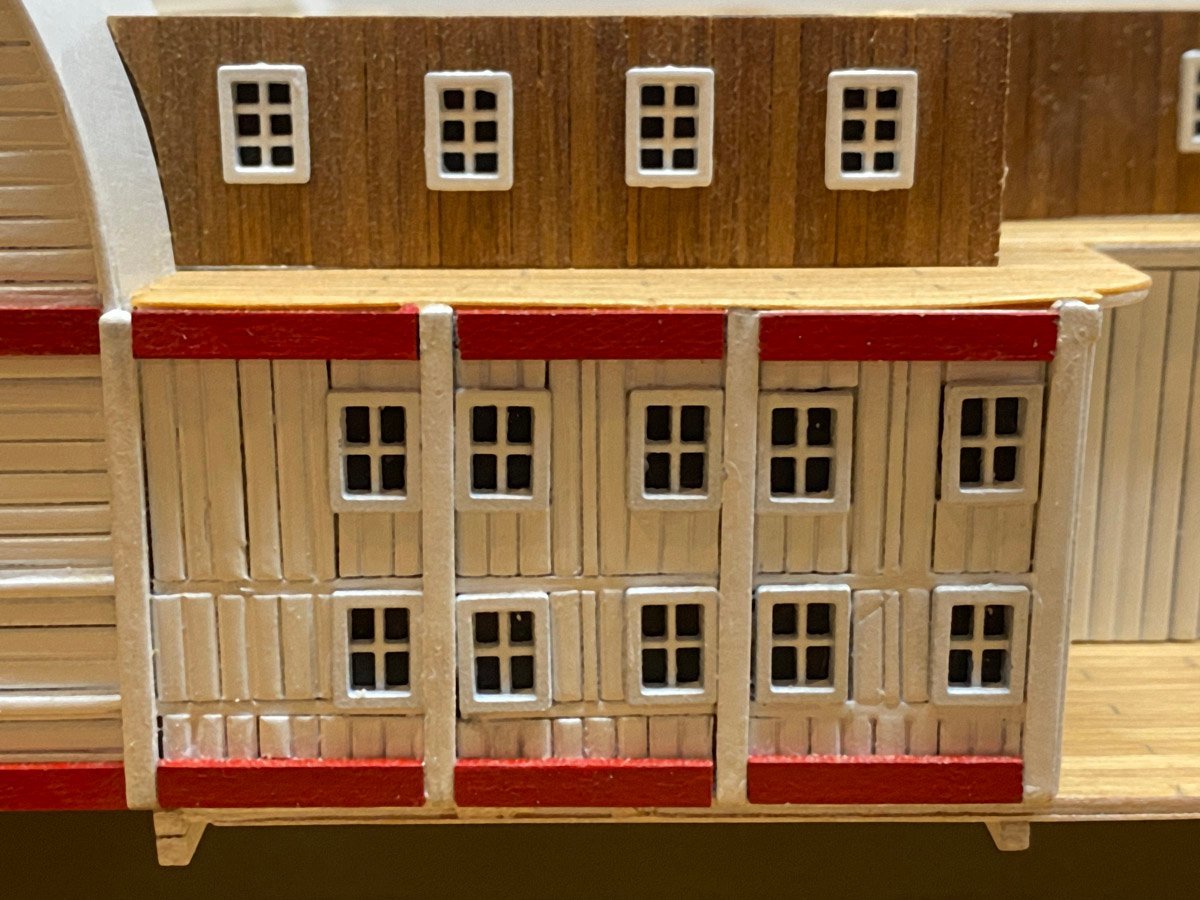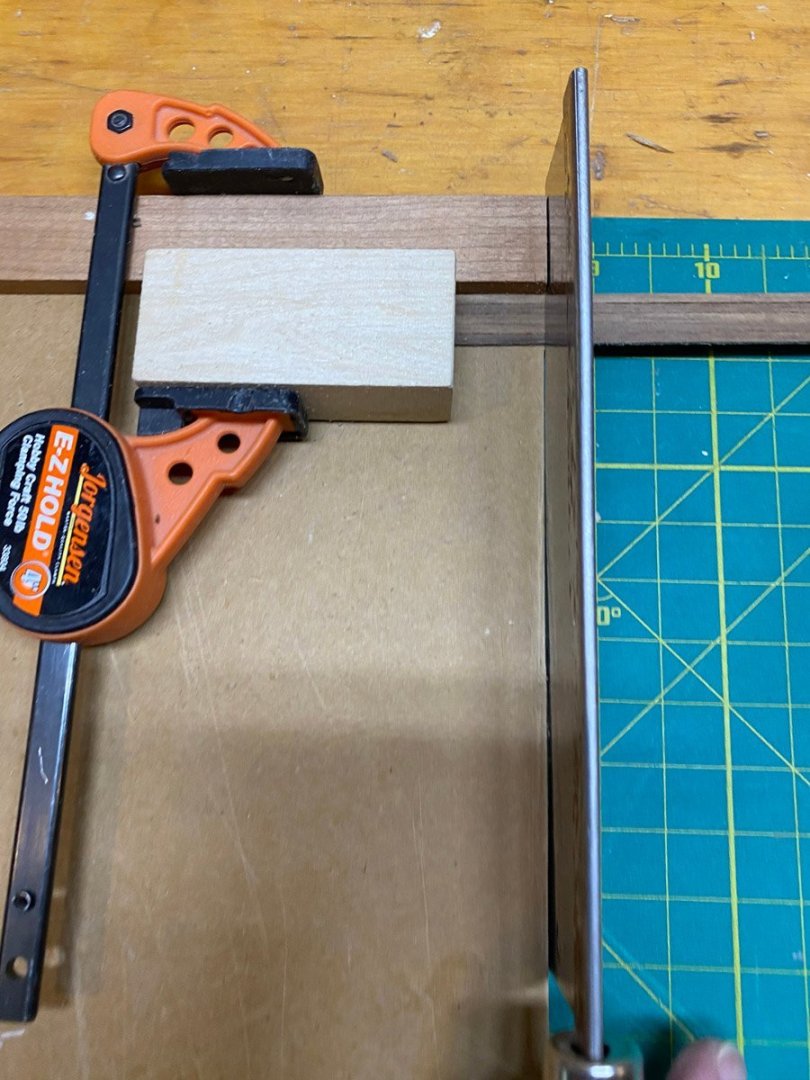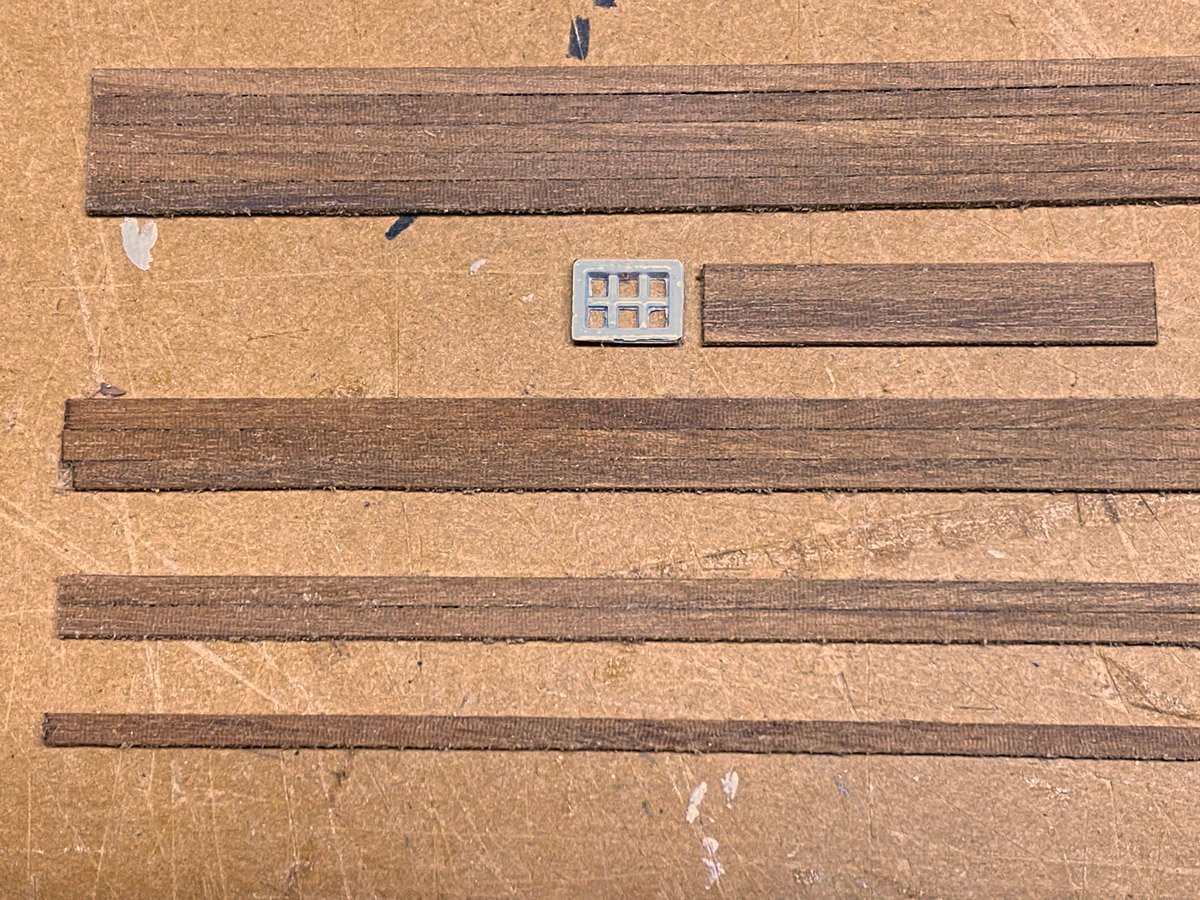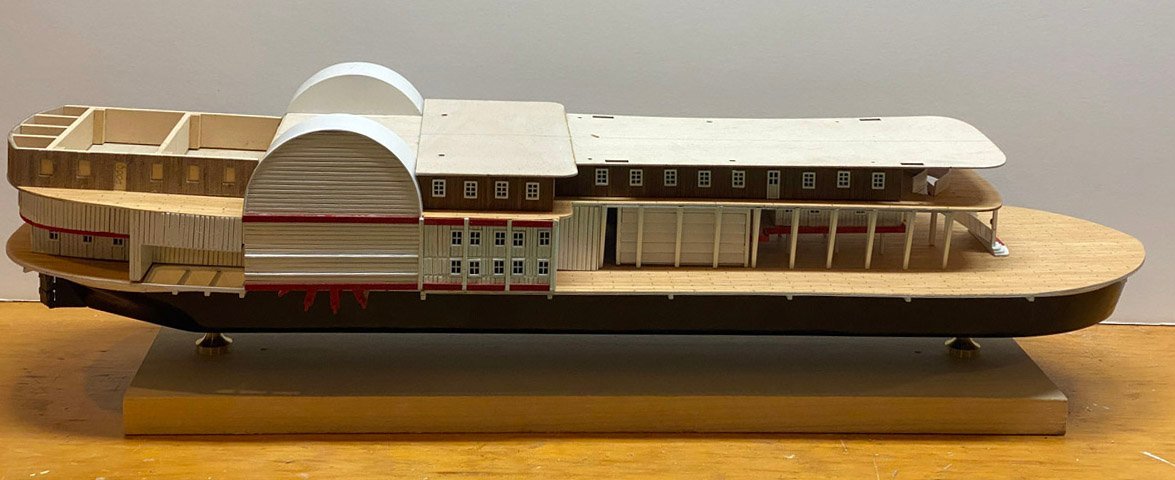-
Posts
695 -
Joined
-
Last visited
Content Type
Profiles
Forums
Gallery
Events
Everything posted by rvchima
-
Allan, Interesting question about the stove. I certainly don't know the answer - I usually build to the plan and discover historically inaccuracies later. Perhaps someone else will know. Rod
- 96 replies
-
- Sphinx
- Vanguard Models
-
(and 2 more)
Tagged with:
-
First Layer of Planking Complete - 72 Hours, 50 days A little bit of caulk and a little bit of paint, Make a carpenter what he ain't. At least that's what a painter told me, and it sure is true of the first layer of planking. I filled all the gaps with Famowood filler and did a lot of sanding. Foam sanding pads work beautifully. One thing that came in very handy was a remote controlled extension cord for my shop vacuum. As soon as the dust began to build I grabbed the hose, pressed the button, and had the dust cleaned up in no time. Here are several photos of the first layer of planking. The kit includes several braces to maintain the width of the hull during planking. Trouble is they are made of MDF, and I broke them off so many times that I had to reinforce them and tape them in place. But they did their job.
- 96 replies
-
- Sphinx
- Vanguard Models
-
(and 2 more)
Tagged with:
-
No, I Haven't Given Up Actually I just returned from an 11 day trip to Maui with my wife, two sons, and their wives. Before I left I made an embarrassing mistake. Despite several warnings in the manual I started planking the hull with wet wood. When I got home there were some serious gaps between the planks. I've planked several hulls in my life and totally know better. I spent a couple of days filling and sanding, and it shouldn't cause a problem on the first layer of planking. I am now pinning wet strips to dry overnight, then gluing them the next day with PVA on the long edges and CA on the bulkheads. The photo shows the hull about half planked with wet planks and gaps, 3 rows with dry planks attached, and 3 more rows of wet planks pinned to dry overnight. This is all working out much better. I prefer to mount my models on brass pedestals rather than using cradles. It makes them much easier to handle during construction and to move when finished. I just ordered two pedestals, and added some reinforcements along the keel to attach them to. While waiting for planks to dry I built the stove. It comprises a surprising number of wood and photo etched brass parts.
- 96 replies
-
- Sphinx
- Vanguard Models
-
(and 2 more)
Tagged with:
-
Gun Ports, And A Piece That Just Didn't Fit Right These little pieces get glued vertically to define the sides of the gun ports, like this. Then thin plywood strips get painted red and glued to the insides of the gunwales. (Test fit before painting shown.) The fit was perfect, but after I had attached everything I discovered a gap between the gunwales and the horizontal notched strip. And so, deconstruction. I removed the notched strip and found that the gunwale pieces matched the notches in the MDF frames perfectly. I have no idea how the notched strip ended up so high, and on both sides. But I glued it back in the correct position. I also stained and attached the second deck with laser-marked planking. The next step is to pre-soak thin ply panels for the outer gunwales. Before I glued these I discovered another gap between them and that same notched strip. There wasn't enough material on the MDF frames to fair the hull any more, so I filled the gaps with 1/16" square strips. It looks like this will all be covered with another deck and rails later. So future Sphinx builders, keep an eye on that notched strip. Consider attaching the inner gunwale pieces first to make sure that strip sits right on top.
- 96 replies
-
- Sphinx
- Vanguard Models
-
(and 2 more)
Tagged with:
-
Hi Mugje, I just looked at your log. If you can do beautiful planking like that you can certainly do the rigging. I really enjoy building the masts and yards, and doing all the rigging. But I have four fully-rigged ships in my house, 3 in cases that I built from scratch, plus three modern warships in another very large case, plus two large tugs and several smaller ships. I just don't have room for another large ship. But who knows, I may just break down and rig this one too 😀
- 96 replies
-
- Sphinx
- Vanguard Models
-
(and 2 more)
Tagged with:
-

For the Beginner Modeler
rvchima replied to kgstakes's topic in Modeling tools and Workshop Equipment
I use my Proxxon oscillating sander constantly. It's perfect for removing laser char, and attachment nubs from photo-etched brass. The sandpaper pads that come with it are terrible but I make my own with double-sided tape and my favorite sandpaper. I even use foam sanding pads to make tiny pads that will follow contours. -
I started the model a week before Christmas and have managed to make a little progress. Bow & Stern Filler Bow and Stern Filler pieces are made from a number of small MDF parts attached to a backing plate and sanded to shape with a rotary tool. Sanding was a little bit intimidating but came out just fine. The purple take in the third photo holds a temporary piece in place to protect two delicate vertical frame pieces. Keel & Frames I forgot to take a photo of the basic keel with frames attached, so I'll jump ahead a little here. The keel is a single piece of MDF, and the frames drop perfectly into slots. Nothing is glued at first. The manual says to place the lower deck with laser-burned planking lines on the frames. Neither the manual nor most of the build logs say anything about finishing the sub deck, but I went ahead and used a coat of Minwax Golden Oak oil stain and three coats of satin Polycrylic spray. Now I realize that you can't see that deck on the finished model, but hey, I know it's there. Longitudinal gun port frames are attached to the top of the frames, then everything is glued with diluted PVA glue painted on from below. In this way the lower deck and longitudinal frames keep everything in alignment as the glue drys. You know the laser-cut wooden toys/puzzles that are so common now? Names like ROKR, UGEARS, and RoWood? So far this model reminded me of those - no skill necessary. I think that planking the hull will be a different story. Four lower coamings with gratings made of pear wood are assembled and attached to the lower deck. Note to Self: These precisely thin laser-cut pieces can be extremely delicate! Don't ask me how I know. The stern counter is made up of nine frames. Horizontal supports for the gun deck are attached next, and then longitudinal supports are attached on top of them. The kit includes a cradle to hold the model during construction. It matches two frames exactly, but until the hull is planked I am using two spring clamps to keep the hull from slipping off. Next the gun sub-deck is attached in two pieces. Remember what I said about "no skill necessary?" I take that back. The gun deck was very hard to fit. The notches were all a little tight, and the two pieces wouldn't quite match up along the center line. I placed, removed, sanded, and replaced the two pieces for hours, and still ended up with gaps between them. Eventually a nicer deck will go over top so it won't matter.
- 96 replies
-
- Sphinx
- Vanguard Models
-
(and 2 more)
Tagged with:
-
What's in the Box A photo of the box is at the top of my first post. The box weighs a hefty 13.5 pounds (6.1 kg). Here are a couple of composite photos of box contents. A lot of the weight is paper - a beautiful 152-page manual and 23 sheets of plans. The cannons, figurehead, and stern decoration are 3-D printed. The hull is double planked with lime wood and pear wood. The masts and yards are walnut. Most of the blocks and rigging material will go into my leftover box if I stop with a hull-only model. The kit includes 33 sheets of laser-cut MDF for the frames and pear wood for most everything else, 1 sheet of laser cut acetate for a stand, and 5 sheets of photo-etched parts.
- 96 replies
-
- Sphinx
- Vanguard Models
-
(and 2 more)
Tagged with:
-
I finished my Mississippi River Steamboat Robert E Lee in early October, and took a break from ships to build a TV console for my son and daughter-in-law. In the evenings I was looking for a new ship to build - something beautiful but challenging that would not need to go in a case. I found a build log for HMS Fly (Amati) built by moderator @ccoyle. Chris built his model as a hull model, no masts, yards, or rigging. What a brilliant idea! He built all the fun bits without ending up with a dust catcher. I started searching for other ships that might look good as a hull model and found the Diana by Caldercraft. I asked Chris for advice, and he told me that my taste was consistent as both models had been designed by @chris watton, owner of Vanguard models. I ordered the Sphinx and had it within a week, but haven't been able to start it until now. There are at least 18 build logs for the Sphinx on MSW, 7 finished, 3 in progress, and 8 stalled. Here are links to the finished logs for easy reference. HMS Sphinx 1775 (prototype) by James H - Vanguard Models - 1:64 - FINISHED 12 pages, 5.5 months. This is the prototype build used for photos for the beautiful manual in the kit. HMS Sphinx 1775 by Blue Ensign - FINISHED - Vanguard Models - 1:64 scale 29 pages, 16 months. Built as a hull-only model. HMS Sphinx 1775 by Glenn Shelton (glennard2523) - Vanguard Models - 1:64 10 pages, 5 months. Glenn wasn't happy with his work (which looked great to me) and stopped with a hull only model. HMS Sphinx 1775 by glennard2523 - FINISHED - Vanguard Models - 1:64 - V2 Kit by Glenn Shelton 16 pages, 11 months. Glenn started over and completed an even nicer model. HMS Sphinx 1775 by mtaylor - FINISHED - Vanguard Models - 1:64 17 pages, 10 months. Mark also stopped with a hull-only model. A very nice build. HMS Sphinx by ECK - FINISHED - Vanguard Models - 1:64 Only 3 pages, 5 months. A fast build with a short log, but the model is gorgeous. HMS Sphinx 1775 by Hollowneck - FINISHED - Vanguard Models - 1:64 19 pages, 16 months. Amazing model with full sails mounted in a diorama.
- 96 replies
-
- Sphinx
- Vanguard Models
-
(and 2 more)
Tagged with:
-
John, I have kept plans from every model that I've made since I was a teenager, so I am not interested in selling the Bismarck plans. The Amati plans comprise two full-color glossy books with 210 pages total and seven full-sized drawings. You might try to get them from Amati. There is a full set of how-to-build the Hachette Bismarck videos on YouTube. This may be enough to get it built.
-
Thank you all for the gracious comments. I enjoy the work and do appreciate all the feedback. It often surprises me how frequently I refer back to my old posts to see how I did something or what kind of paint that I used. So the build logs are a useful reference for me, and I hope that they will help other modelers in the future. I will be starting on a woodworking project, a TV console cabinet for my son, so no posts here for a while. Eric, thank you for the perspective on lifeboats. I suspected that they were impractical and maybe unnecessary on riverboats. However, Smithsonian Magazine had an interesting article, When Deadly Steamboat Races Enthralled America, with some pretty grizzly statistics about steamboat disasters, mostly due to fires or boiler explosions. It makes steamboats seem somewhat less glamorous.
- 58 replies
-
- Robert E Lee
- Amati
-
(and 4 more)
Tagged with:
-
Steamboat Robert E Lee is Finished, 269 Hours, 102 Days Since returning from a trip to Utah to visit five national parks, I've put in about 40 hours to complete the rigging, accessories, and deck furniture. Here are photos of the final model. The masts and yards were fairly complicated, with the hinged joints between them made up from brass tube and sheet. The chain supplied for the gangways is tiny and required magnifiers to work with. The gangways would never hang in place by themselves so I glued small black wedges to keep them were I want them. The kit includes two very nice metal and wood anchor kits and a really cute turned capstan. The instructions said to use 1 mm wood strips for the capstan bars, but the turned base had 1 mm round holes so I used brass rod. When I clipped the rod to length after assembly the ends were rough so I touched one gently to my disk sander, and the sander grabbed it and dragged the whole thing into the gap between the spinning disk and table. That really mangled the capstan. I sure wish I had taken a photo. I ended up turning a new capstan on the end of a dowel. Here's the new one and what's left of the old one. The ship has two tiny lifeboats for 240 or more passengers, and no davits for launching them. There is one more lifeboat or ship's boat hanging from a boom at the stern. Like the gangways there is no way this would hang correctly by itself, so I pinned it to the stern. Summary You can't go wrong with a kit by Amati. They have excellent materials and detailed plans, and end up as beautiful models. The illustrated instructions for the Robert E. Lee are in Italian. An English translation is included but you need to refer back to the Italian for illustrations. The build sequence was confusing. Instead of building cabins upward from the lower deck, they are built down from the deck above. That allows you to plank and paint the cabin walls, but it makes it quite confusing to see which parts all need to line up. The instructions recommended rounding the edges of the cabin wall planks. I regret doing that on the lower decks - the paint didn't get into the joints and it makes the work look sloppy. I did not round the planks on the upper decks. You can still see hints that the walls are planked but they look much cleaner. I also found that I could pre-glue several planks to a sheet of brown paper, glue that to the cabin walls, and trim the length later. That gave a much neater look. This is not an easy model. All the planking, windows and doors, and a surprising amount of rigging add up to a lot of work. In the end, though, Amati's Robert E Lee builds into a beautiful model.
- 58 replies
-
- Robert E Lee
- Amati
-
(and 4 more)
Tagged with:
-
Eric, Thank you for the explanation about the "chains". I didn't think they were actual chains but I wasn't sure. Anyway I was planning to use heavy black thread with tiny, hand-made turnbuckles. Photos to follow.
- 58 replies
-
- Robert E Lee
- Amati
-
(and 4 more)
Tagged with:
-
Bcochran, Thank you for the drawings of the R. E. Lee. I do wish that I had them earlier to avoid A HUGE MISTAKE The plans above show the stacks close to the cabins on the Texas deck. The kit had holes pre-drilled in the decks that I assumed were for screws for the stacks. I realized that I could never tighten screws in that location so I used short dowels to attach the stacks from above, and I built the stacks and braces to fit those holes. Turns out they are way too far apart. This is where the stacks should be. This is where my stacks are. I didn't realize my mistake until I started to attach supports for hull chains. The hulls on river steamers were so long and shallow that they tended to flex, and had to be braced with chains like a suspension bridge. This image from The Western Rivers Steamboat Cyclopaedium by Bates shows typical supports and chains. The Amati kit has the supports, although most of them stop at the top deck. The front support does go through all of the decks, right next to the stack, probably through the pre-drilled hole that I centered the stack on. Fortunately there was just enough room to place the support next to the stack. But how to drill the hole? Years ago I needed to thread an electrical wire through a wall, and made a very long 1/8" drill out of a piece of wire. It worked perfectly to drill through the decks for the support piece. Here's the drill, and the support piece in place. All the other support pieces are dummys, attached only to the upper deck. So my stacks are too far apart, but I can still squeeze the chains in place.
- 58 replies
-
- Robert E Lee
- Amati
-
(and 4 more)
Tagged with:
-
Status - 225 hours, 68 days The decks, railings, and smokestacks are all attached and the working base has been replaced with a beautiful cherry base from Bluejacket Shipcrafters. It may seem like there's not much left to do, but looking ahead in the instructions it's obvious that there is plenty. There are masts, gangways, lots of rigging, and support braces to build. There are 3 lifeboats, 2 anchors, and a capstan to build. There are flags, lanterns, a steam whistle, and other accessories to add. My wife and I are getting ready for a trip to Utah to see 5 national parks, so I won't be posting for a few weeks. Don't worry, I will finish the model eventually.
- 58 replies
-
- Robert E Lee
- Amati
-
(and 4 more)
Tagged with:
-
Smokestacks The forward smokestacks came nicely turned from hardwood. I curved the photo etched trim pieces and attached them to the tops. The stacks are braced side-to-side with three tubes each surrounded by 3 rings supporting 4 wires. The kit did not include the brass tubes so I substituted aluminum that I had on hand. The kit came with extremely thin brass wire so I substituted black thread. Assembly was fiddly but not impossible. I can't imagine how the rings and wires could offer and structural support, so I suppose they were purely decorative.
- 58 replies
-
- Robert E Lee
- Amati
-
(and 4 more)
Tagged with:
-
Trim and Railings The photo etched trim hangs down from the deck above and supports the tops of about 150 columns that go down to the deck below. The instructions say to use 1 mm square walnut strips, but they are hard to paint and keep smooth. I found some 1 mm square x 20" long styrene strips on Amazon that would be delivered the next day. I expected a 20" long package but received a small envelope with the strips rolled up inside. They straightened out some, and when cut to 18 mm lengths the bends didn't show. Everything got attached as follows: Glue trim around the top Glue top of column to trim Glue bottom of column to deck Glue railings to bottom of columns Glue walnut trim to railings It only took a couple of afternoons. The Texas deck got a little porch in front and railings around the top of 6 staircases.
- 58 replies
-
- Robert E Lee
- Amati
-
(and 4 more)
Tagged with:
-
She's looking great Tim. I am totally impressed that you managed to waterproof everything and squeeze all that gear into that awkward hull. I hope that you will post videos of her on the water.
- 72 replies
-
- Seguin
- BlueJacket Shipcrafters
-
(and 2 more)
Tagged with:
-
Texas Deck & Pilot House The captain's and crew's quarters were on the top deck. Since the captain had the biggest quarters the deck was called the Texas deck after the biggest state at that time. The pilot house sits on top of everything, giving the captain a commanding view of the river. Construction was the same as lower decks - basswood frame planked with walnut, leaving room for LOTS of windows and doors. The pilot house itself has 15 windows and one door. Everything was framed with red styrene, and a trim strip of photo etched gingerbread was added inside. There is still a lot of photo etched trim to go. I pre-painted it while still on the sprues.
- 58 replies
-
- Robert E Lee
- Amati
-
(and 4 more)
Tagged with:
-
Not As Bad As I Expected I started those rails yesterday about 5:00 and had them done by 9:30, including dinner and dishes. I pre-painted the column stock. The column heights varied by about 3 mm from fore to aft, so I cut each slightly over sized and sanded for a snug fit. Like Rodgerdodger, I built a brass and wood jig for drilling the columns. Masking tape on the back prevented tear out. Rodgerdodger used music wire for the rails. My instructions said that the rails were metallic thread. My kit has some very fine 0.2 mm brass wire, but also some 1 mm brass rod.* I used the brass rod, and pre-bent it to match the plans as closely as possibly. Then I threaded 4 rails through 6 columns in the proper order, arranged everything on the deck, and applied CA with a glue looper. I only broke two columns in the process. *One problem with this kit is that it includes lots of parts with no explanation as to what they are for.
- 58 replies
-
- Robert E Lee
- Amati
-
(and 4 more)
Tagged with:
-
Onward and Upward Building this ship is like baking a wedding cake - you just keep adding layers on top. (Not that I've ever baked a wedding cake.) The layers from my previous post have all been attached, a layer of skylights has been added, and another layer of cabins is framed. The smokestacks are just there temporarily. There will be four brass rails going through 12 wooden columns around this rear deck. Previous builders have commented on how difficult they are to build. I am not looking forward to that. The sidelights are white metal castings about 2.5 inches long. Every little hole had to be cleaned out with a tiny square file. The red trim pieces are supposed to be made of wood, but there is no way to bend wood around those sharp corners, short of laminating thin strips. I did what other builders have done and used styrene strips. They were painted with the same red paint used elsewhere but came out shinier, brighter, and, well, plastic looking. The ship has 14 staircases made from beautiful wooden strips that must have been cut on a CNC machine. They have to be cut to length and have side rails added. I stained everything with a walnut stain.
- 58 replies
-
- Robert E Lee
- Amati
-
(and 4 more)
Tagged with:
-
Congratulations Harry, she looks great! I like the lights too.
- 118 replies
-
- sanson
- artesania latina
-
(and 1 more)
Tagged with:
-
Lots of nice details on the lifeboats!
- 118 replies
-
- sanson
- artesania latina
-
(and 1 more)
Tagged with:
-
Third Deck Planking The technique of gluing planks to a paper backing is working extremely well. The 2 mm walnut strips supplied with the kit are about 20" long, and I am gluing up 10" segments of 2, 3, 4, and 5 strips, plus segments of 1+2+2+1 mm strips that fit the doors and windows. I put a stop block on my cutting board to cut pieces to the height of the cabin. I saw with paper side down so the wood doesn't tear when the saw cuts through. Another big advantage is that when I mess up and glue something crooked, it cuts off easily through the paper backing and just requires a little sanding to remove the paper. I planked the forward cabin, sanded and oiled it in two days. Then painted the window interiors and added the windows and doors in a couple more hours. The flat planks on the walnut cabins look SO much better than the chamfered planks on the painted cabins. The next deck is back to white, and I will totally forget the chamfering. I planked the aft cabin in 3 hours.
- 58 replies
-
- Robert E Lee
- Amati
-
(and 4 more)
Tagged with:
About us
Modelshipworld - Advancing Ship Modeling through Research
SSL Secured
Your security is important for us so this Website is SSL-Secured
NRG Mailing Address
Nautical Research Guild
237 South Lincoln Street
Westmont IL, 60559-1917
Model Ship World ® and the MSW logo are Registered Trademarks, and belong to the Nautical Research Guild (United States Patent and Trademark Office: No. 6,929,264 & No. 6,929,274, registered Dec. 20, 2022)
Helpful Links
About the NRG
If you enjoy building ship models that are historically accurate as well as beautiful, then The Nautical Research Guild (NRG) is just right for you.
The Guild is a non-profit educational organization whose mission is to “Advance Ship Modeling Through Research”. We provide support to our members in their efforts to raise the quality of their model ships.
The Nautical Research Guild has published our world-renowned quarterly magazine, The Nautical Research Journal, since 1955. The pages of the Journal are full of articles by accomplished ship modelers who show you how they create those exquisite details on their models, and by maritime historians who show you the correct details to build. The Journal is available in both print and digital editions. Go to the NRG web site (www.thenrg.org) to download a complimentary digital copy of the Journal. The NRG also publishes plan sets, books and compilations of back issues of the Journal and the former Ships in Scale and Model Ship Builder magazines.



